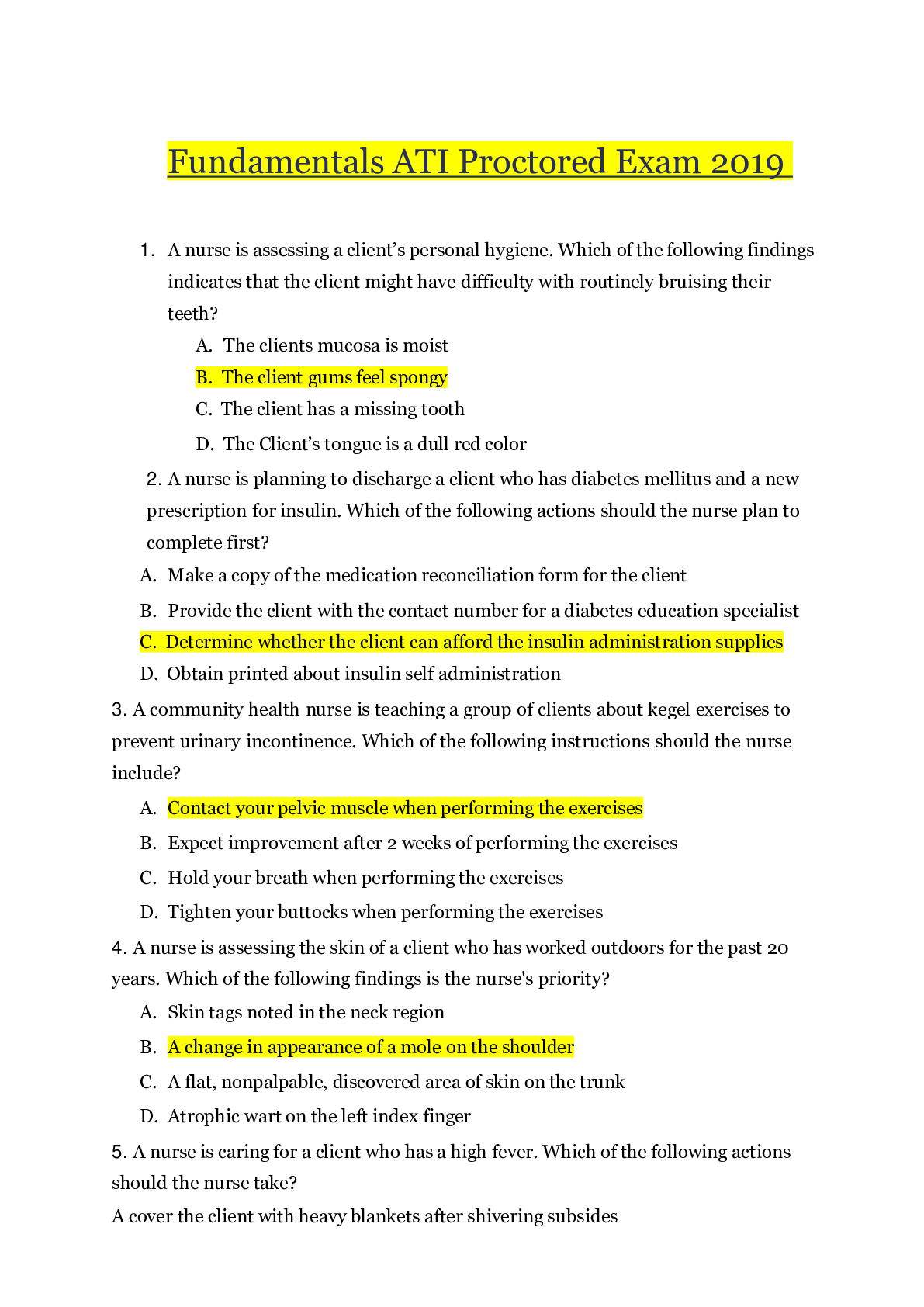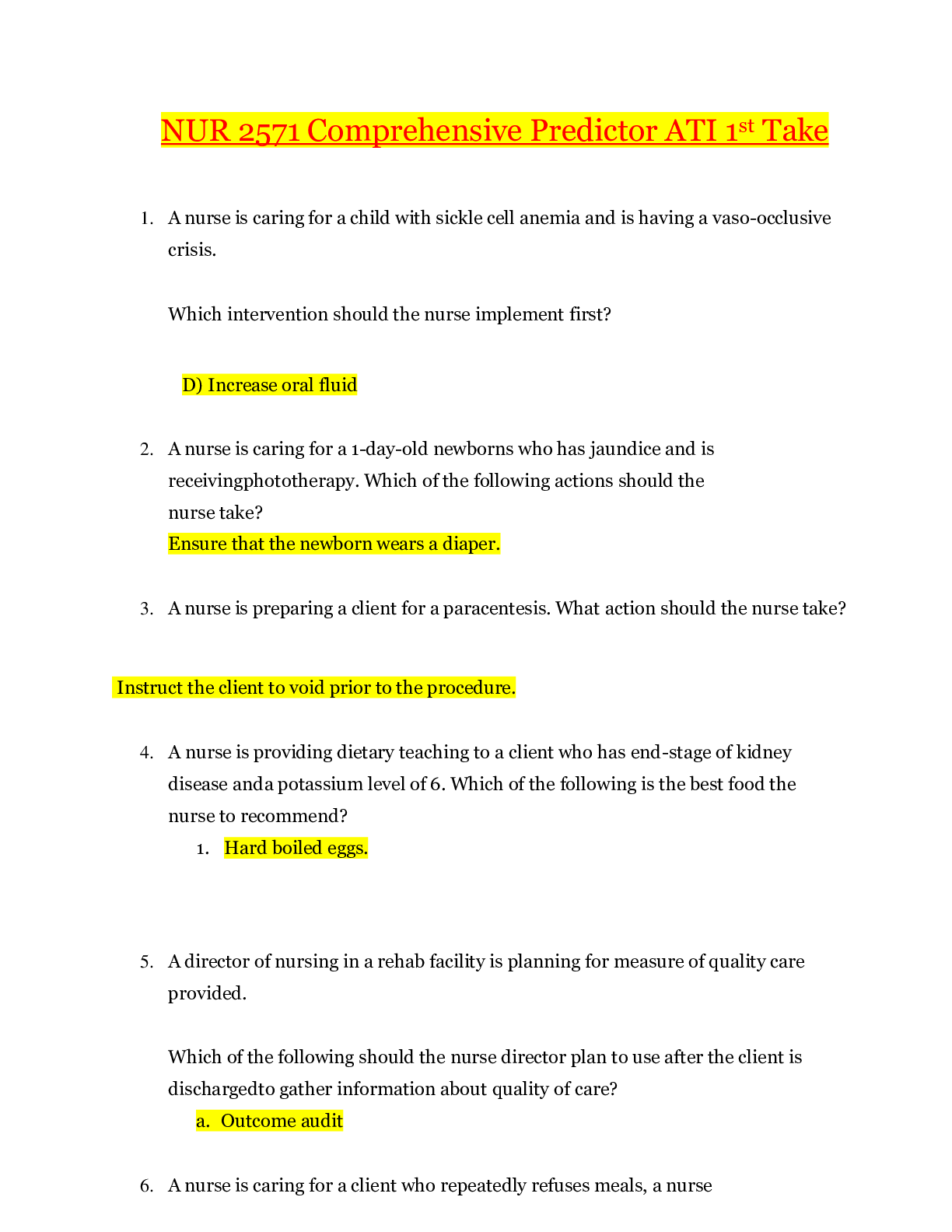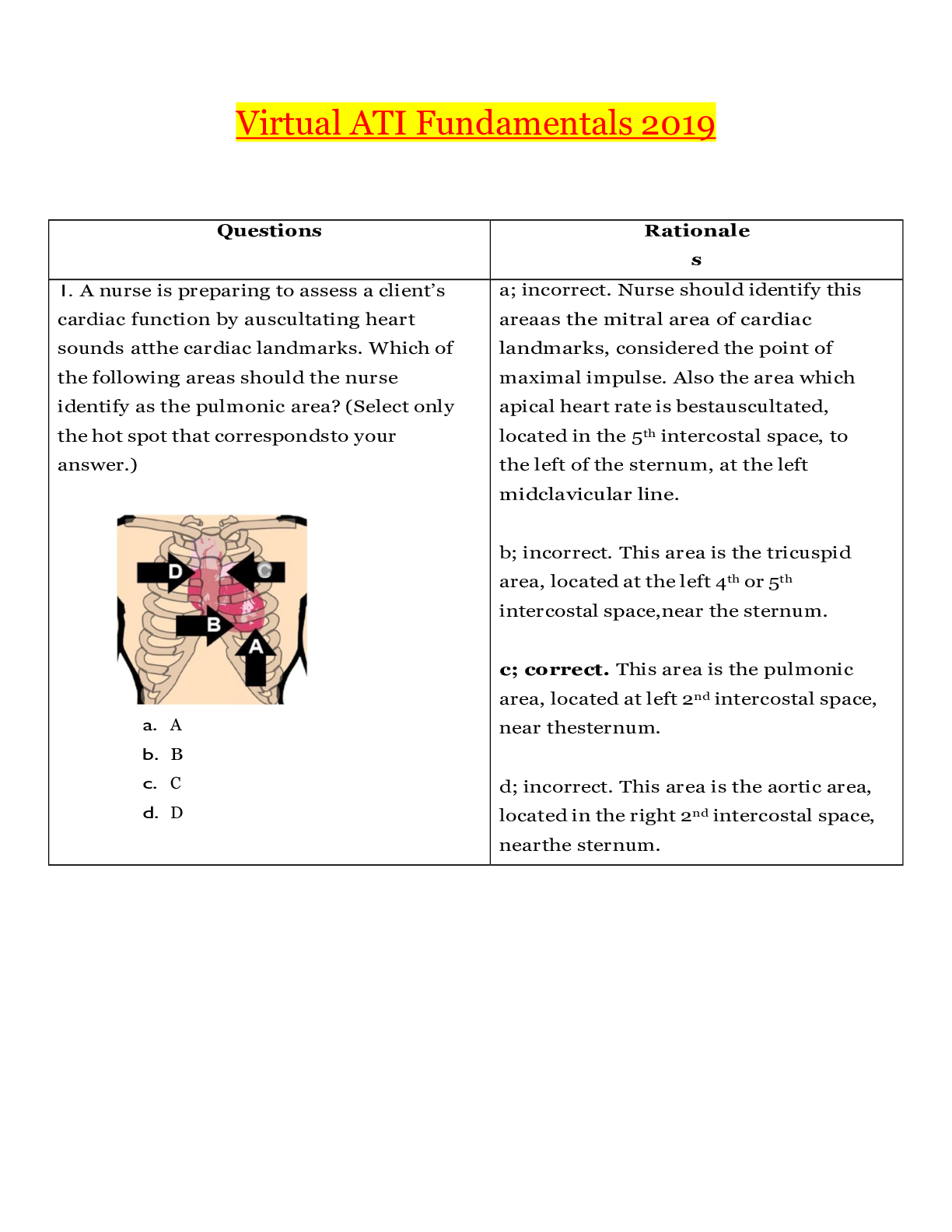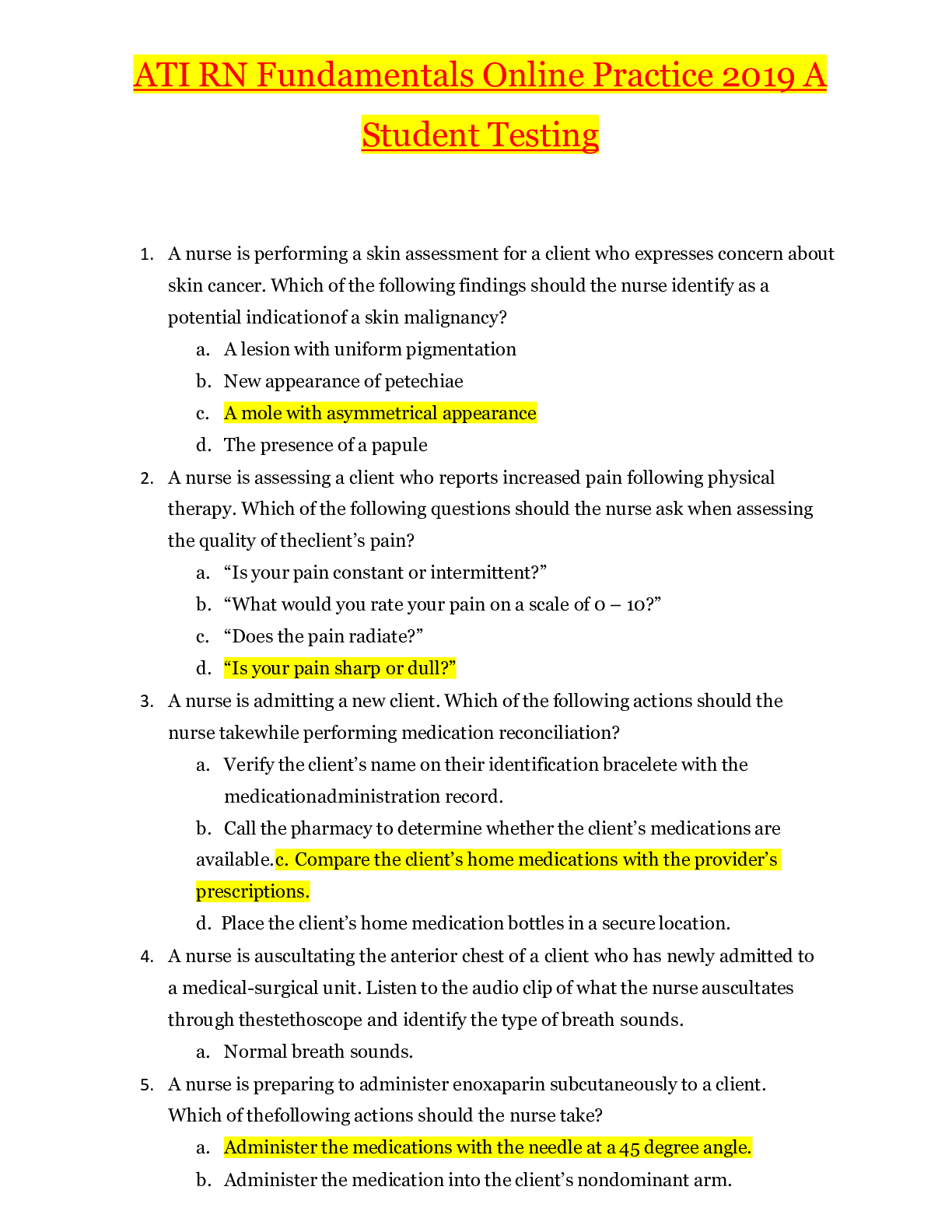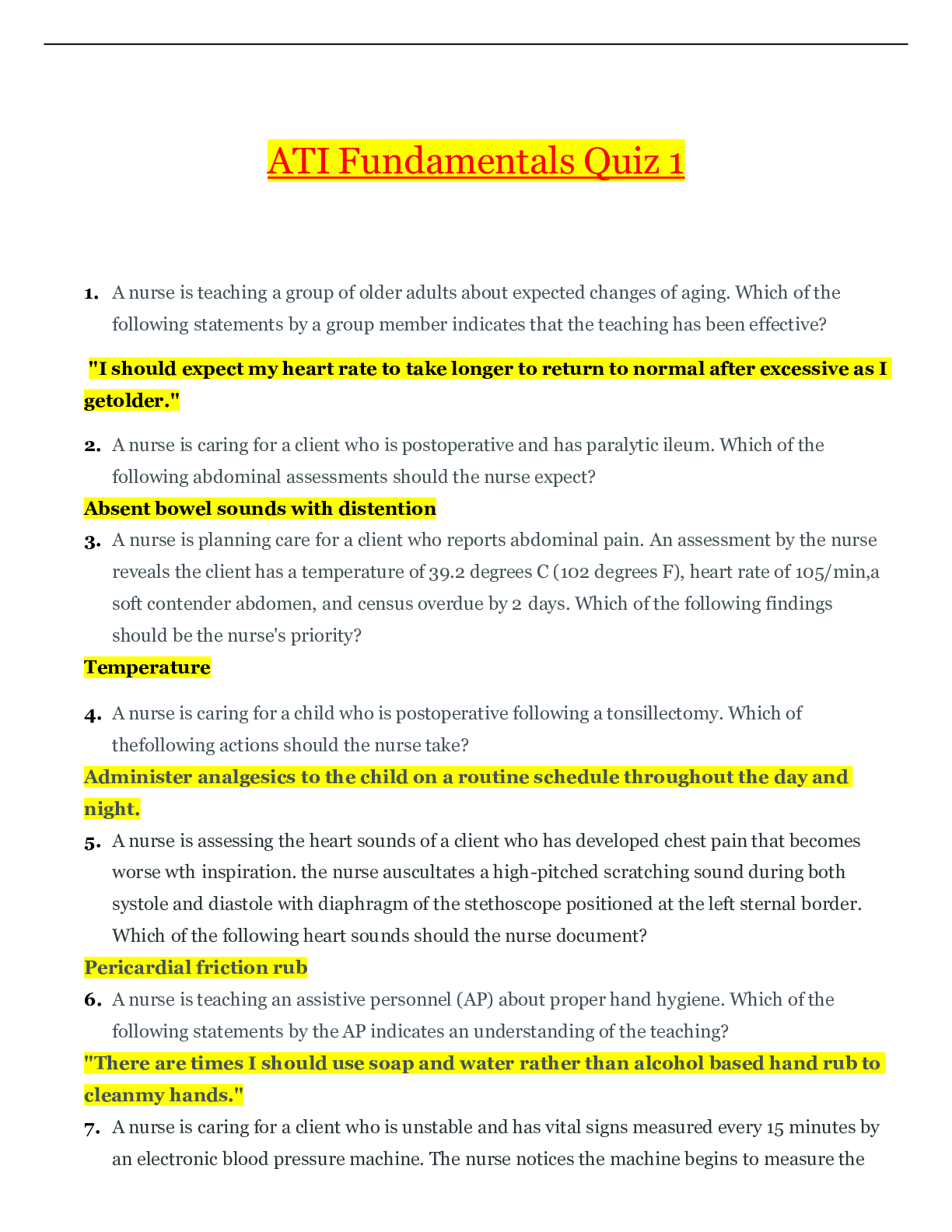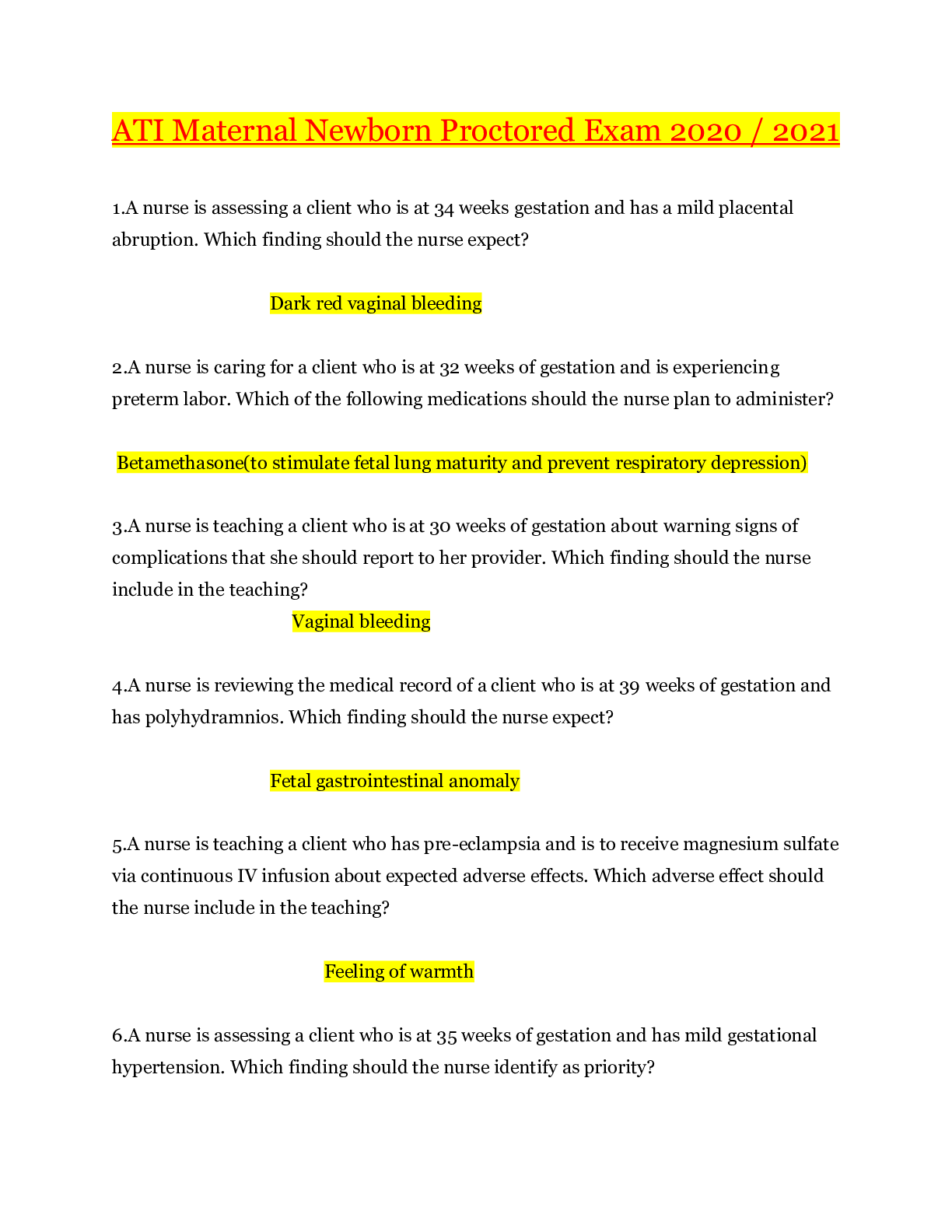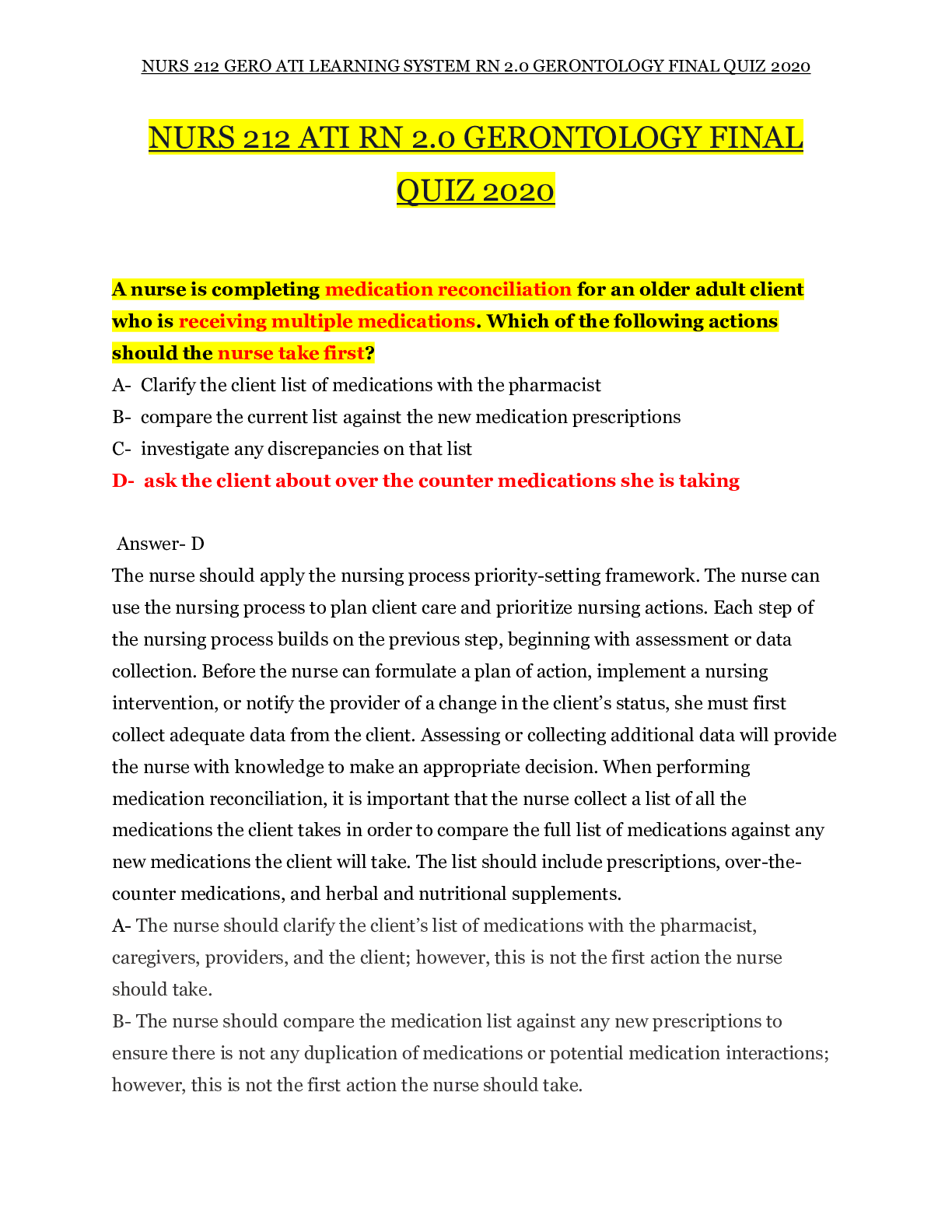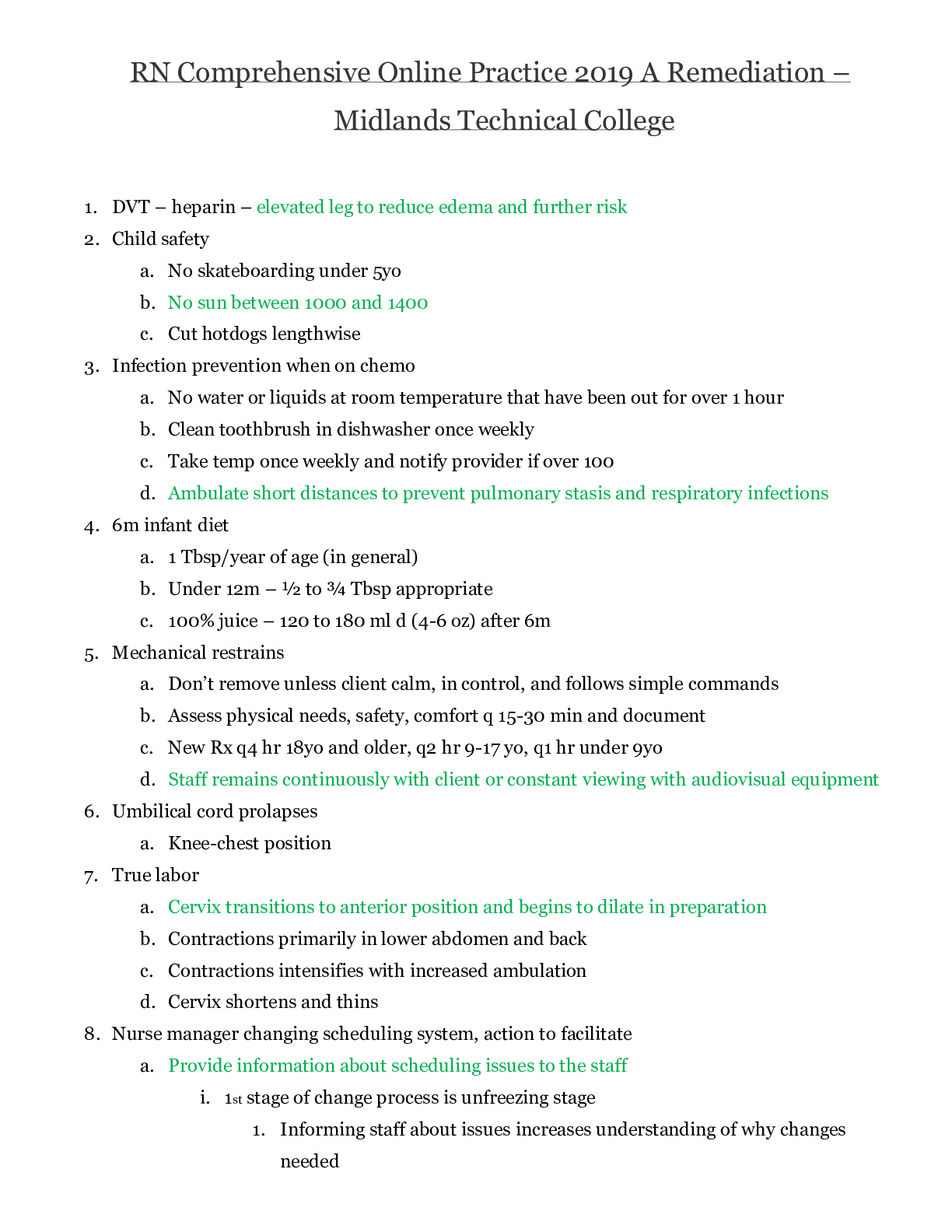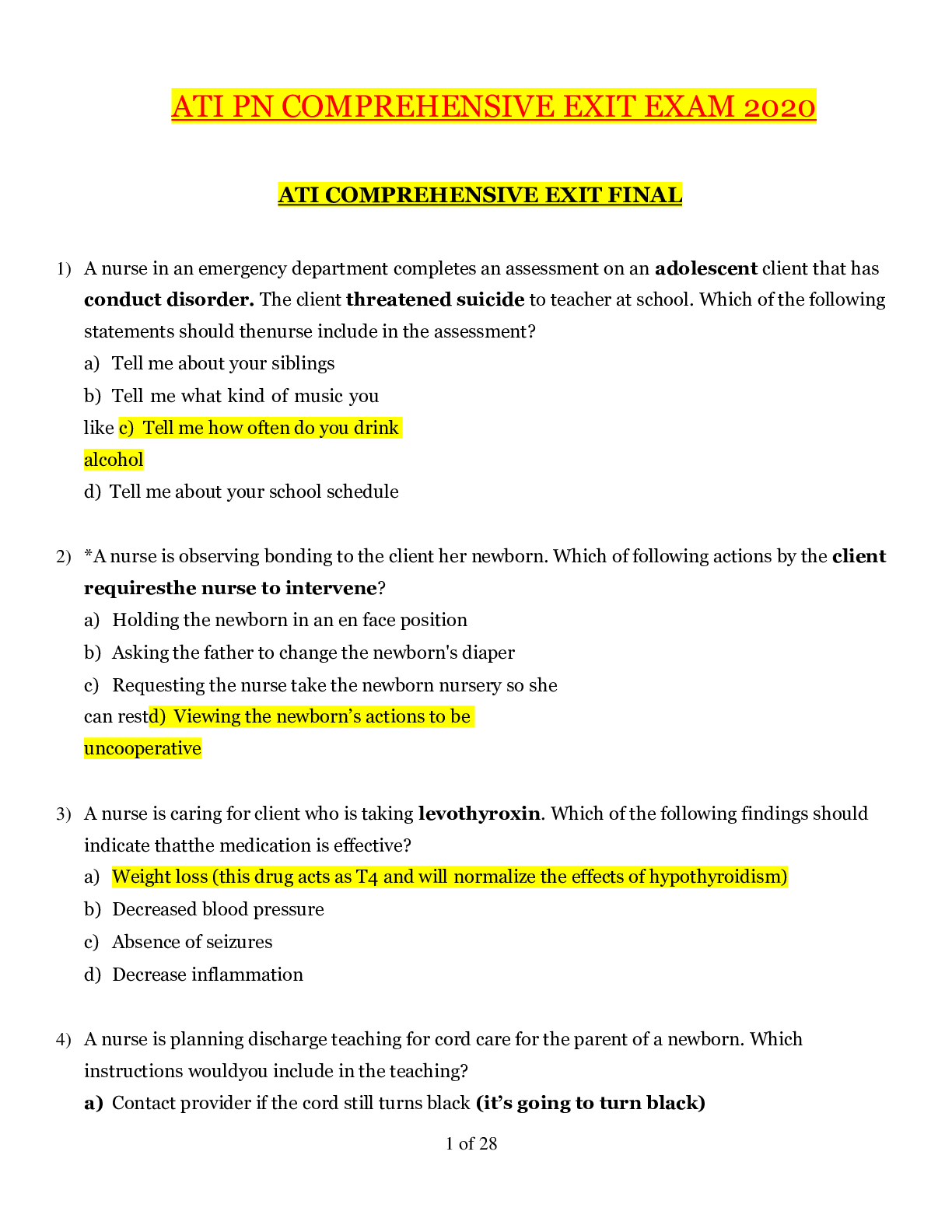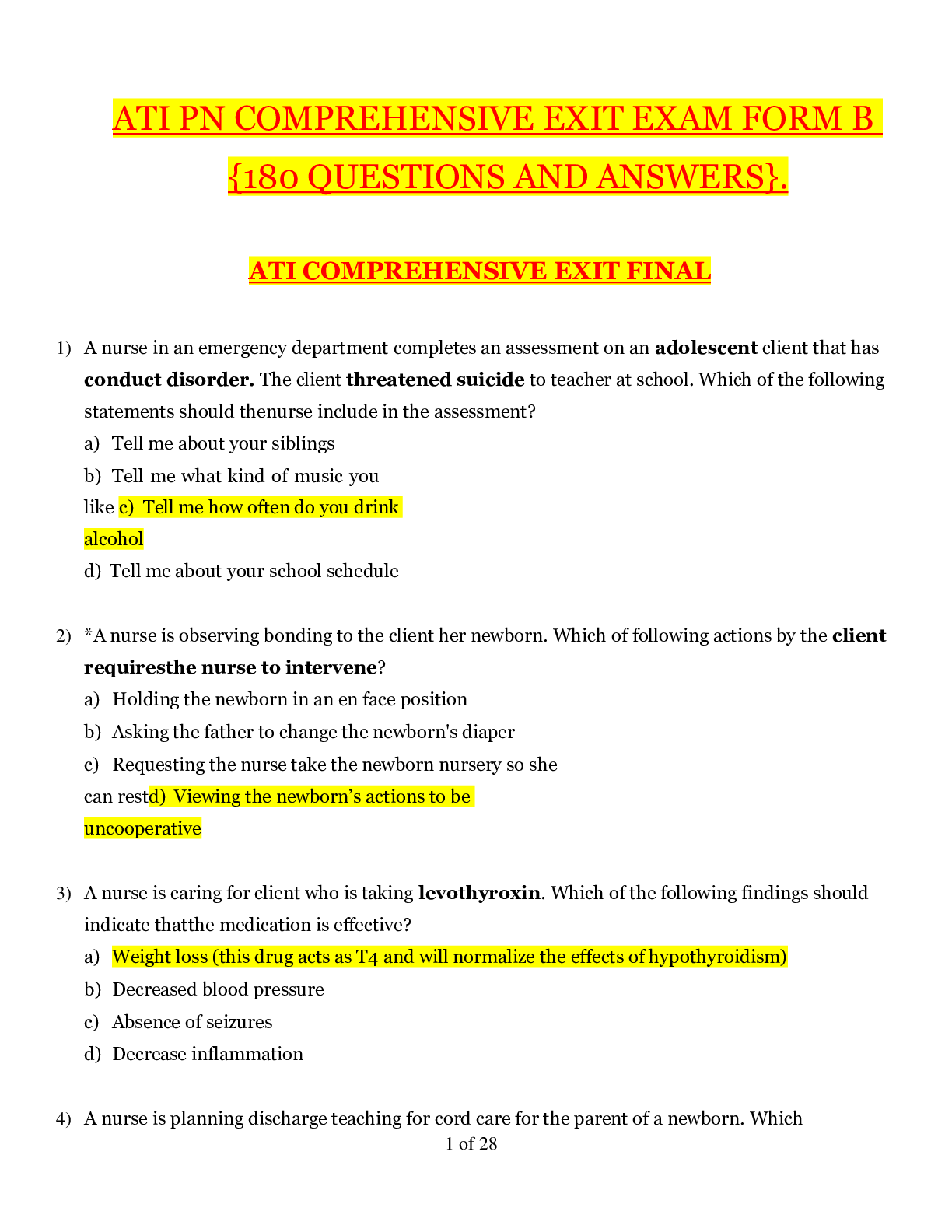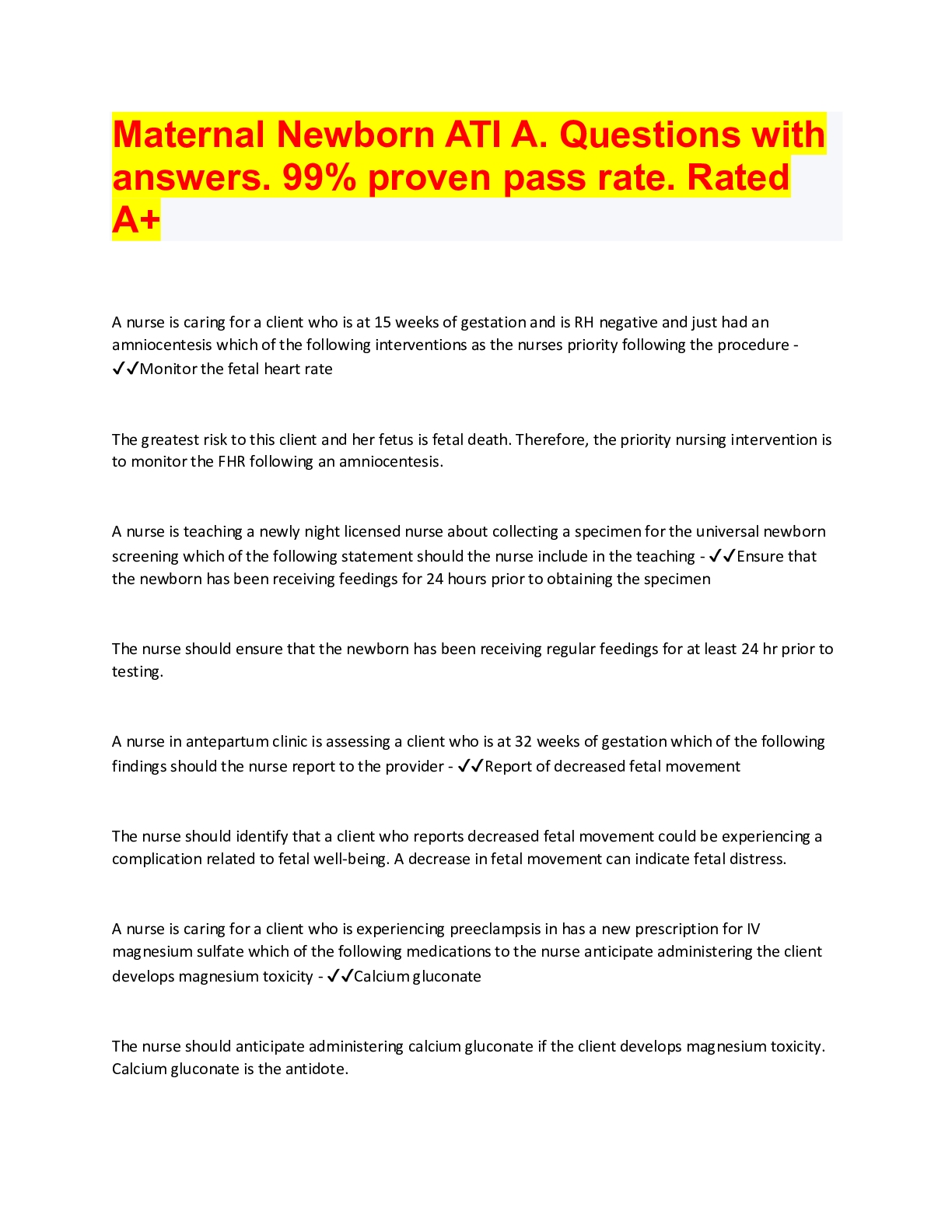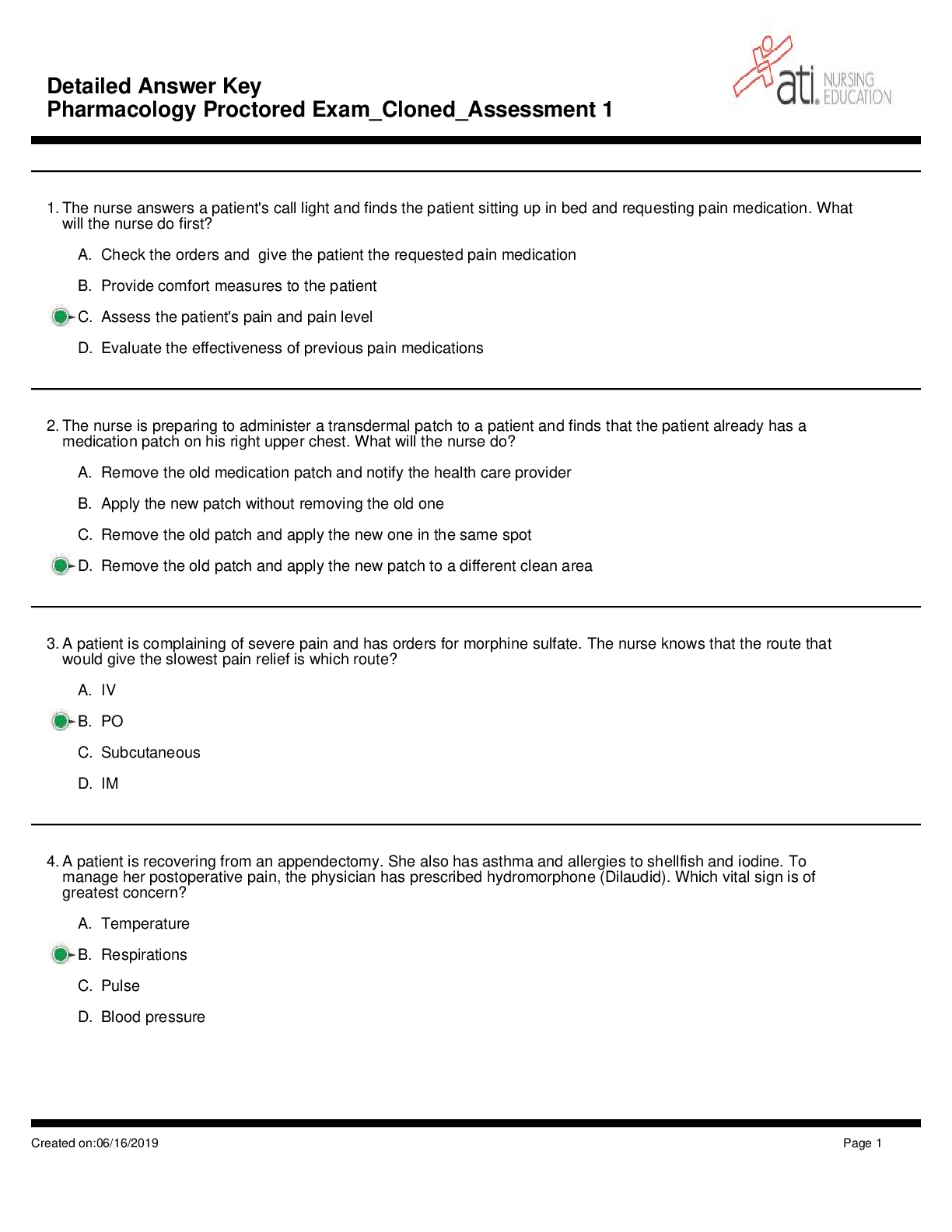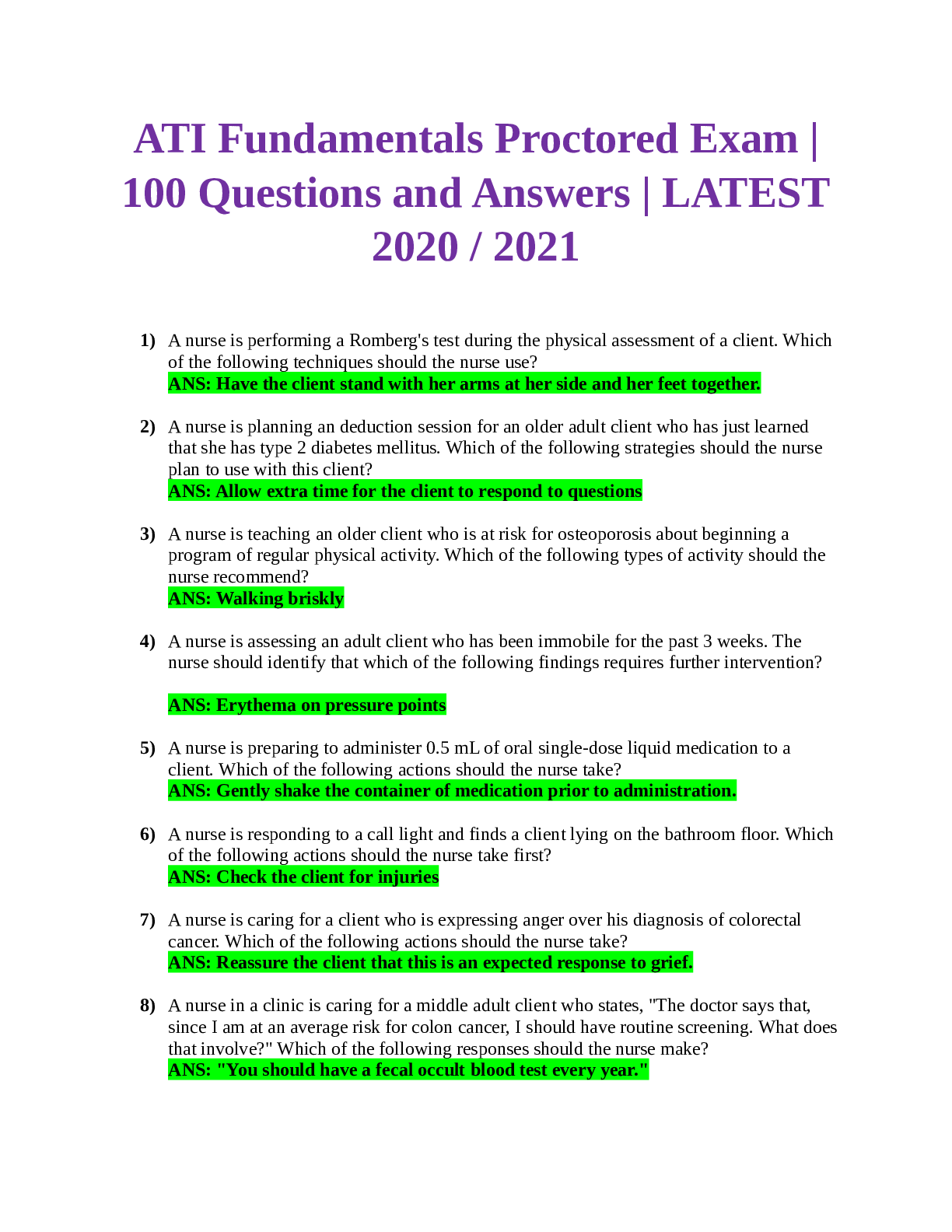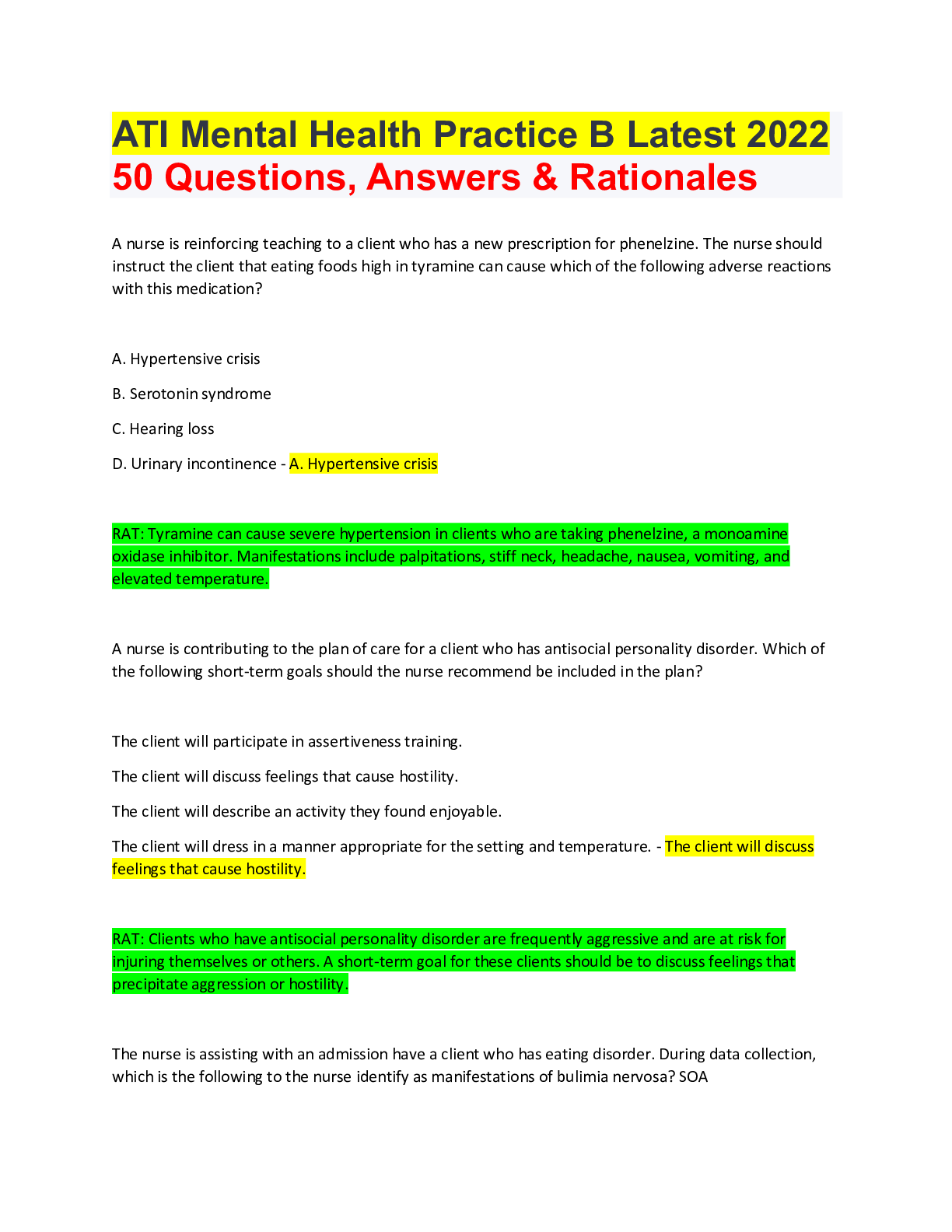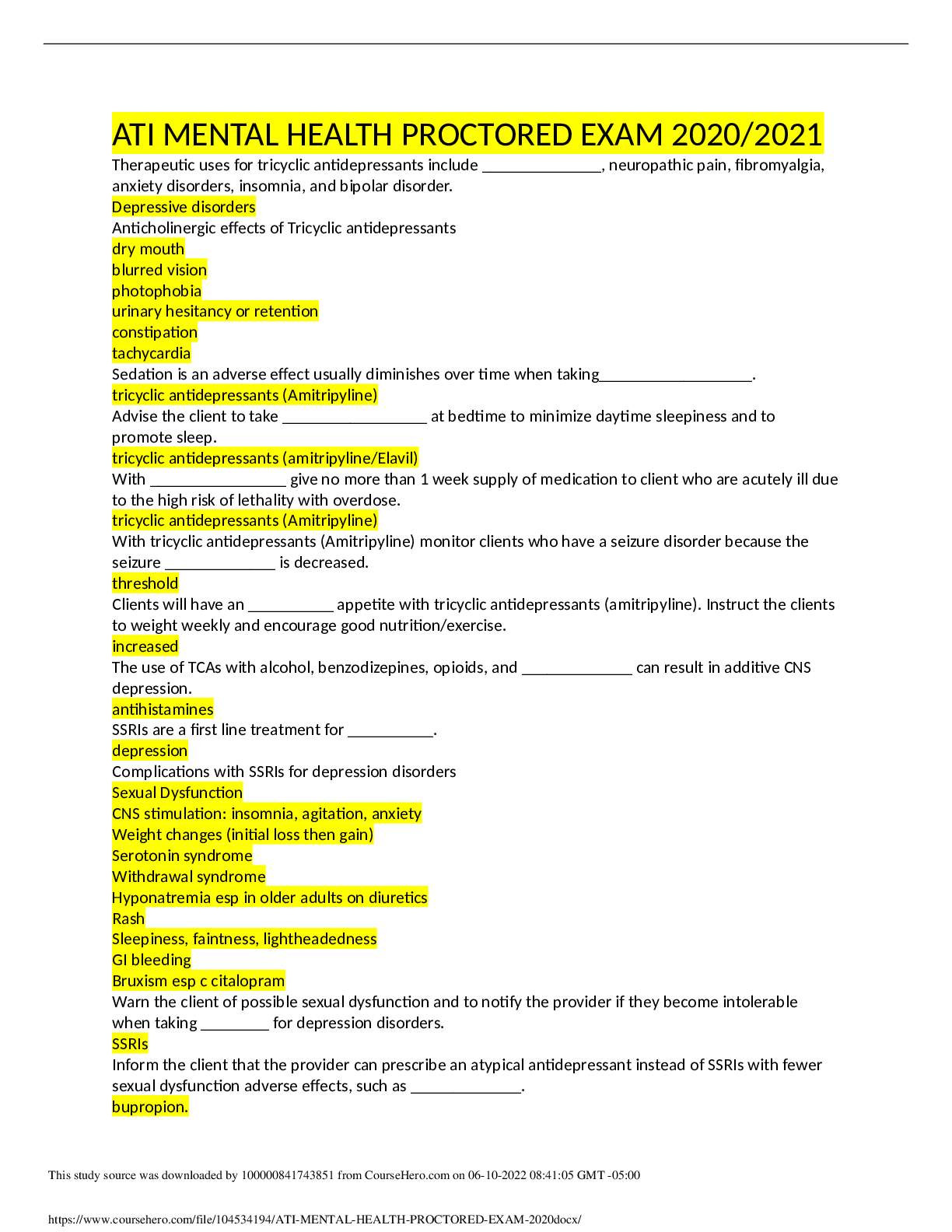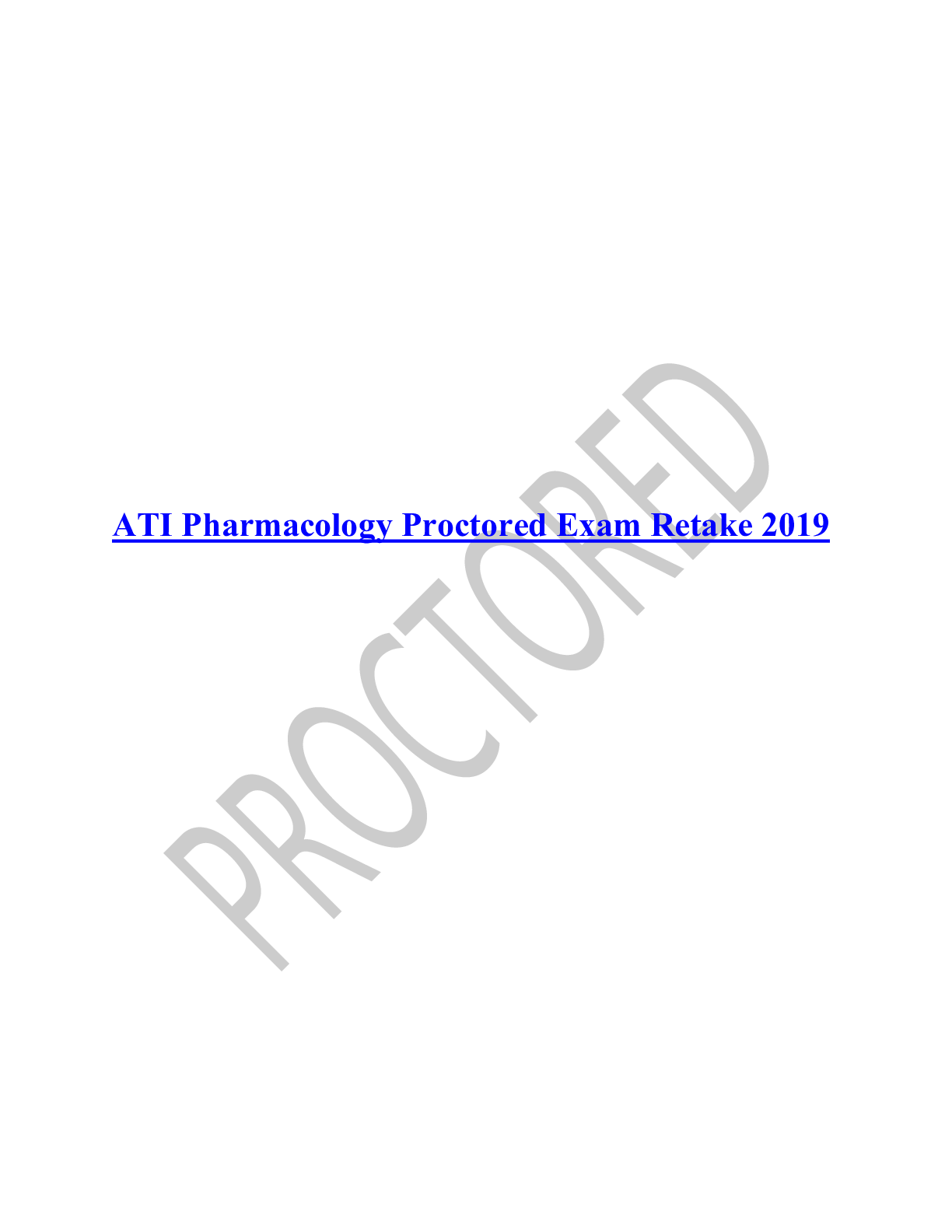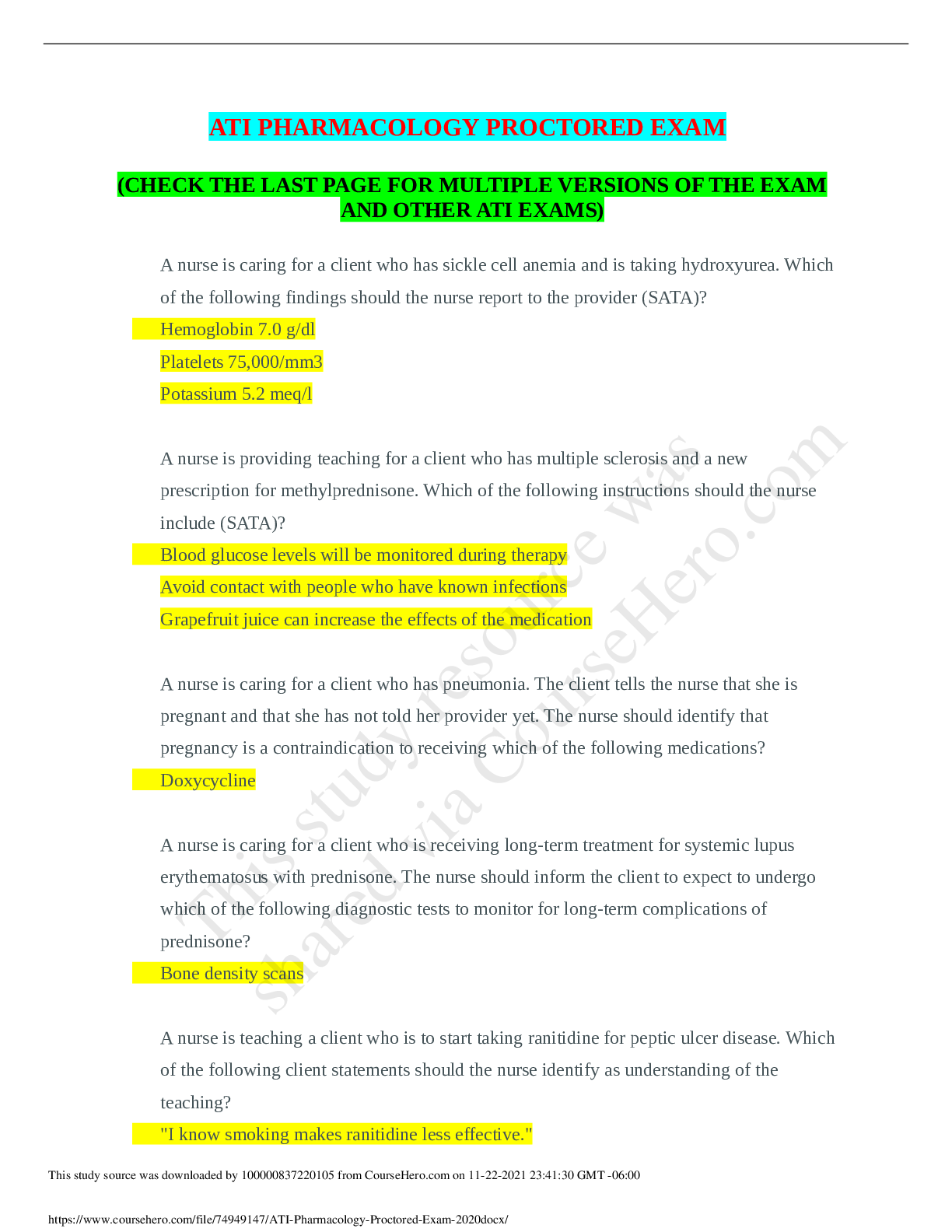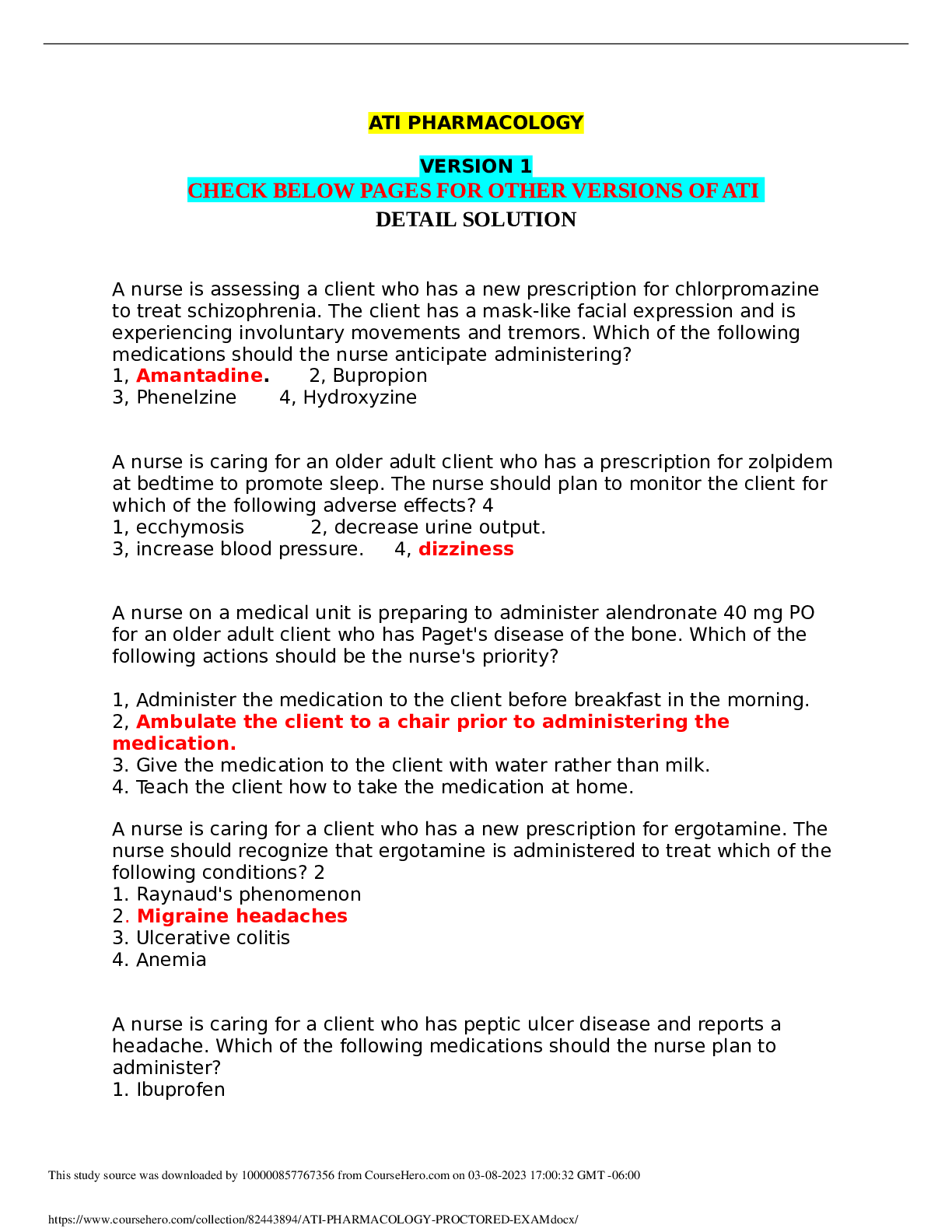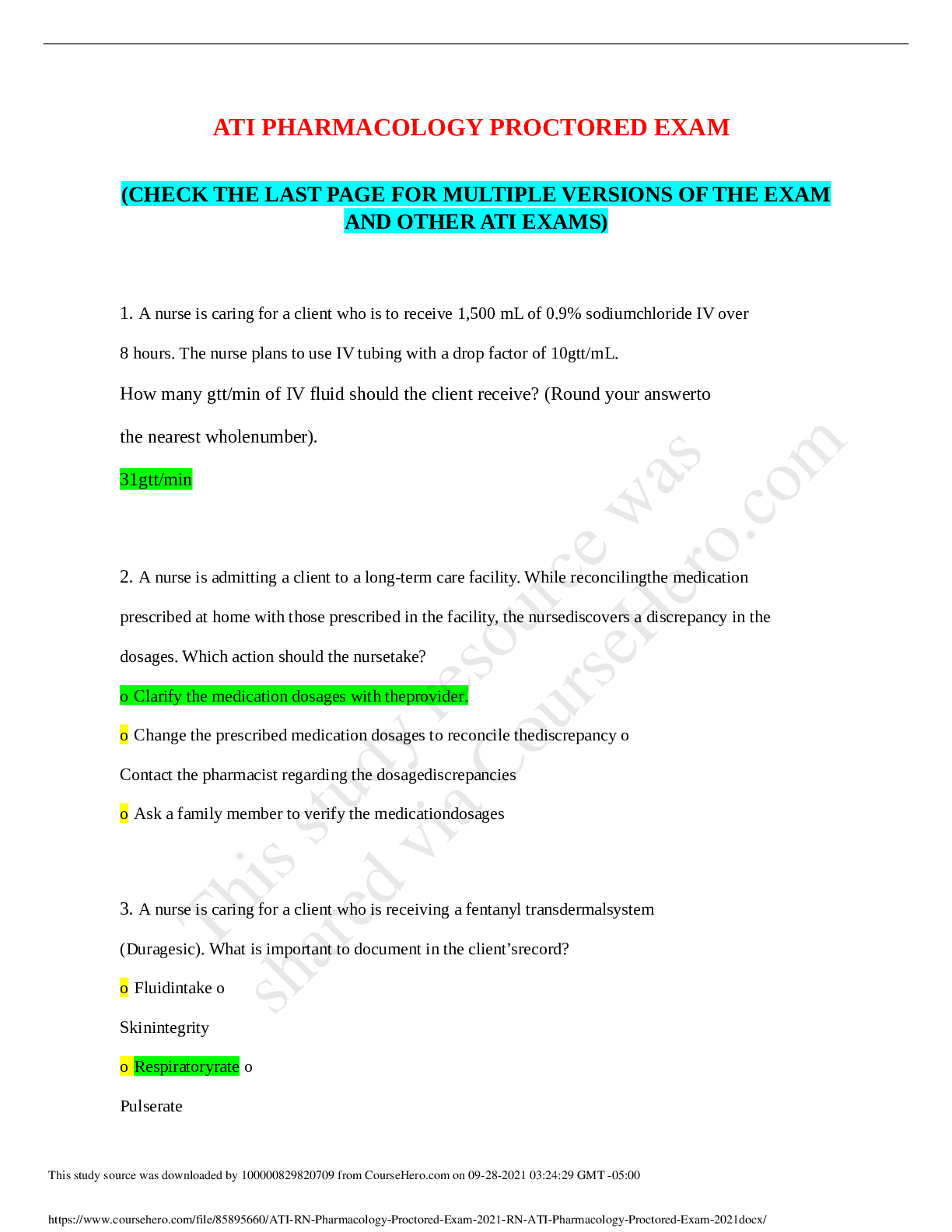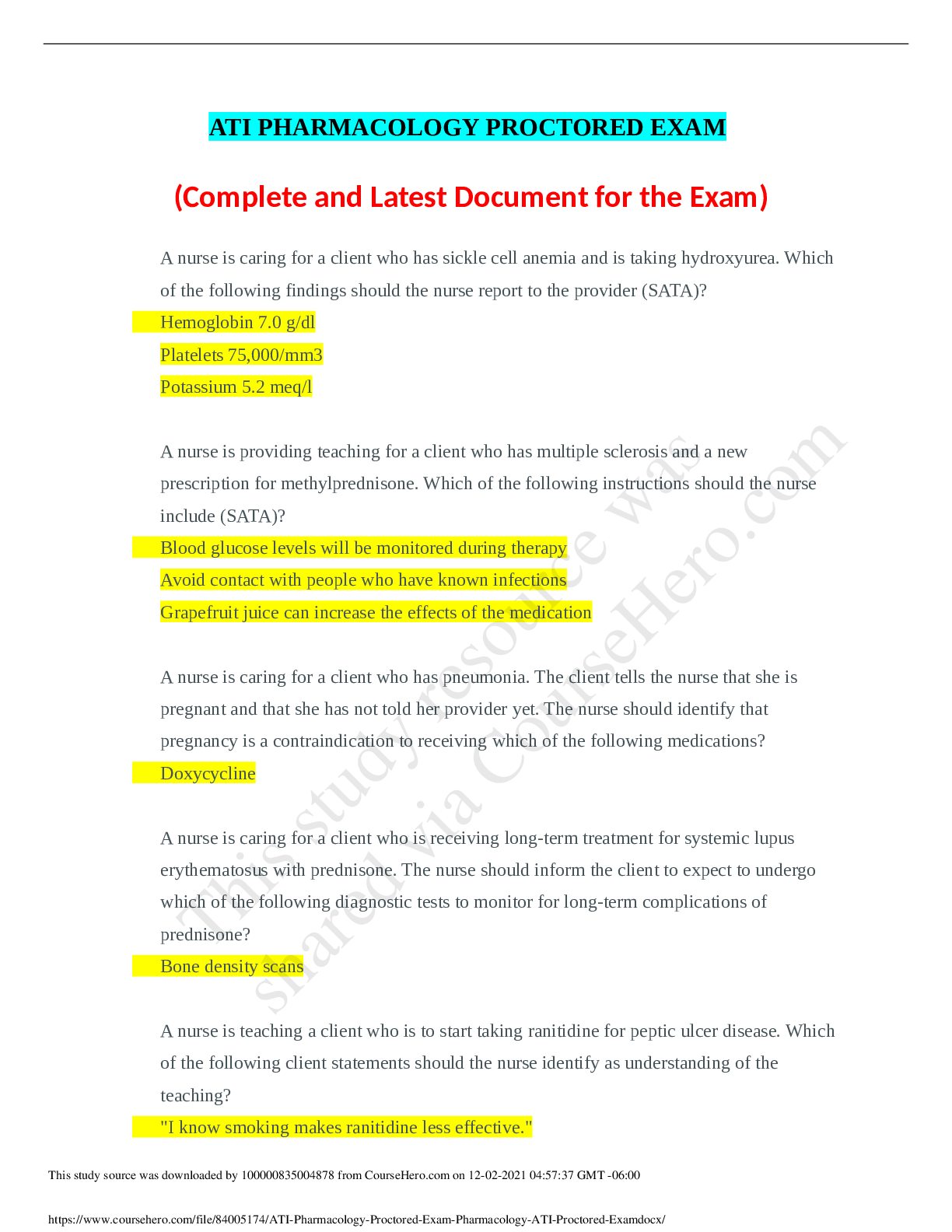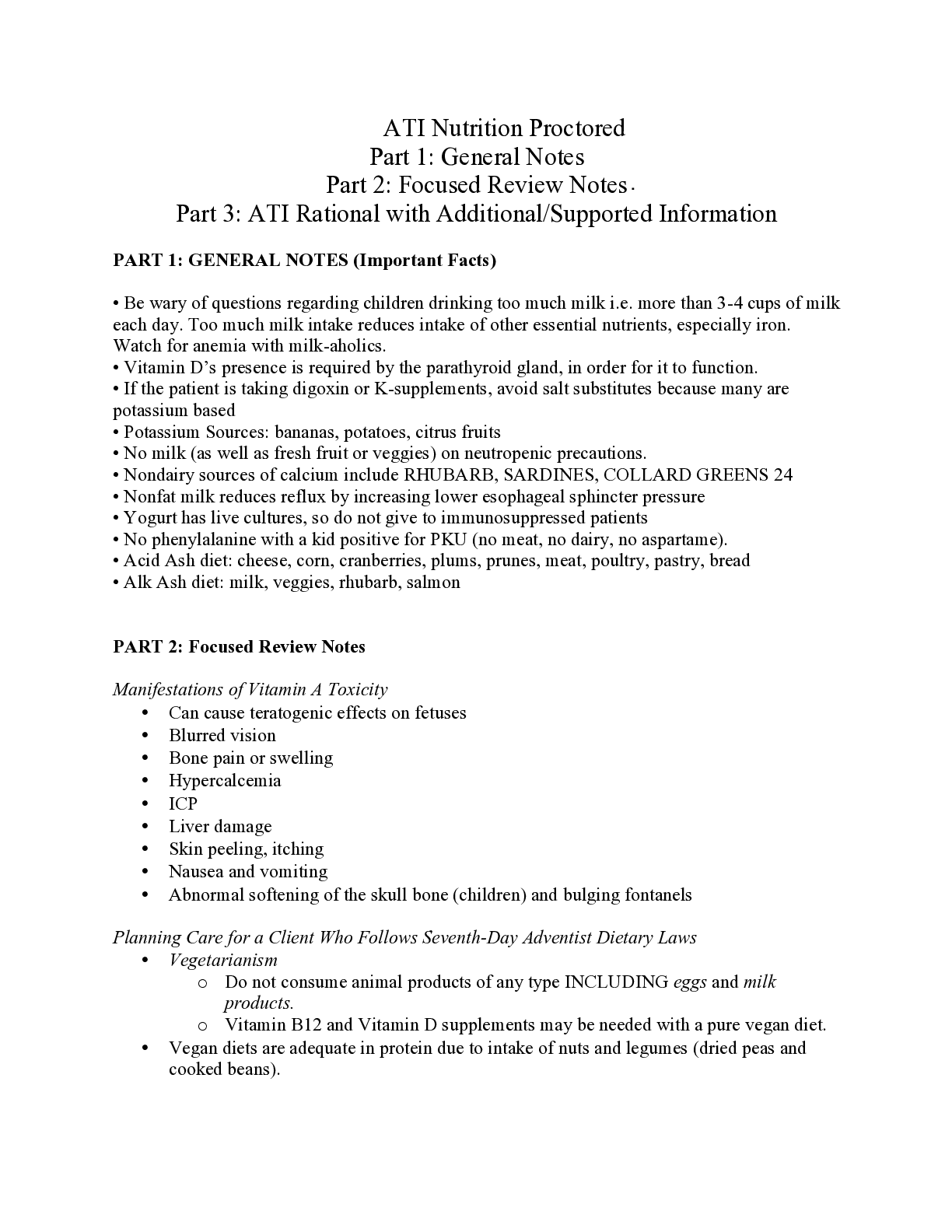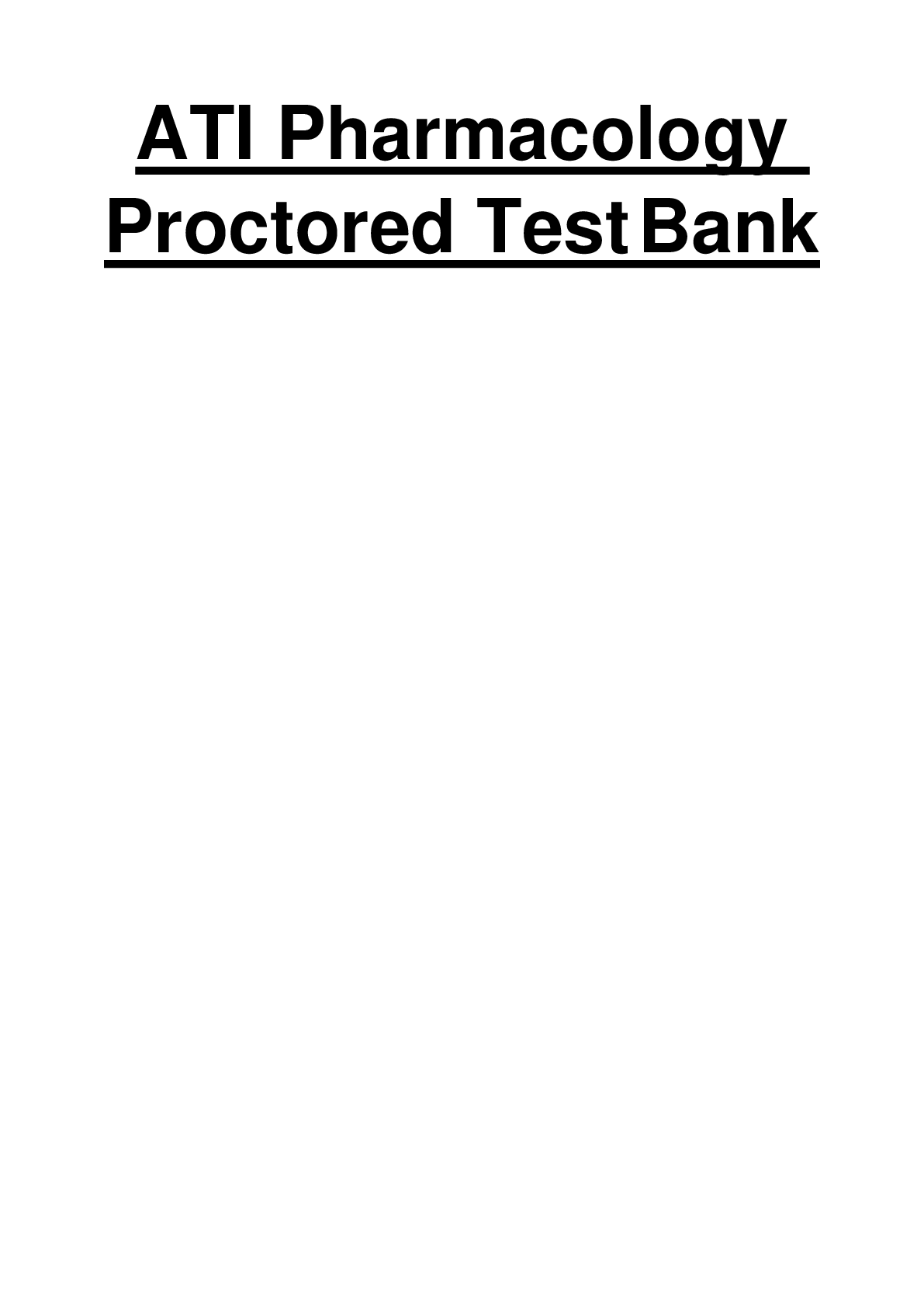Pharmacology > EXAM PROCTORED > ATI PHARMACOLOGY PROCTORED TEST BANK _ 100% VERIFIED ANSWERS | ATI PHARMACOLOGY PROCTORED TEST BANK (All)
ATI PHARMACOLOGY PROCTORED TEST BANK _ 100% VERIFIED ANSWERS | ATI PHARMACOLOGY PROCTORED TEST BANK - ANSWERS & RATIONALE _Grade A
Document Content and Description Below
ATI PHARMACOLOGY PROCTORED TEST BANK _ 100% VERIFIED ANSWERS 313 questions with answers and rationale 1. 1) A nurse is caring for a client with hyperparathyroidism and notes that the client's se... rum calcium level is 13 mg/dL. Which medication should the nurse prepare to administer as prescribed to the client? 1. Calcium chloride 2. Calcium gluconate 3. Calcitonin (Miacalcin) 4. Large doses of vitamin D 2. 2.) Oral iron supplements are prescribed for a 6-year-old child with iron deficiency anemia. The nurse instructs the mother to administer the iron with which best food item? 1. Milk 2. Water 3. Apple juice 4. Orange juice 3. 3.) Salicylic acid is prescribed for a client with a diagnosis of psoriasis. The nurse monitors the client, knowing that which of the following would indicate the presence of systemic toxicity from this medication? 1. Tinnitus 2. Diarrhea 3. Constipation 4. Decreased respirations 4. 4.) The camp nurse asks the children preparing to swim in the lake if they have applied sunscreen. The nurse reminds the children that chemical sunscreens are most effective when applied: 1. Immediately before swimming 2. 15 minutes before exposure to the sun 3. Immediately before exposure to the sun 4. At least 30 minutes before exposure to the sun 5. 5.) Mafenide acetate (Sulfamylon) is prescribed for the client with a burn injury. When applying the medication, the client complains of local discomfort and burning. Which of the following is the most appropriate nursing action? 1. Notifying the registered nurse 2. Discontinuing the medication 3. Informing the client that this is normal 4. Applying a thinner film than prescribed to the burn site 3. Calcitonin (Miacalcin) Rationale: The normal serum calcium level is 8.6 to 10.0 mg/dL. This client is experiencing hypercalcemia. Calcium gluconate and calcium chloride are medications used for the treatment of tetany, which occurs as a result of acute hypocalcemia. In hypercalcemia, large doses of vitamin D need to be avoided. Calcitonin, a thyroid hormone, decreases the plasma calcium level by inhibiting bone resorption and lowering the serum calcium concentration. 4. Orange juice Rationale: Vitamin C increases the absorption of iron by the body. The mother should be instructed to administer the medication with a citrus fruit or a juice that is high in vitamin C. Milk may affect absorption of the iron. Water will not assist in absorption. Orange juice contains a greater amount of vitamin C than apple juice. 1. Tinnitus Rationale: Salicylic acid is absorbed readily through the skin, and systemic toxicity (salicylism) can result. Symptoms include tinnitus, dizziness, hyperpnea, and psychological disturbances. Constipation and diarrhea are not associated with salicylism. 4. At least 30 minutes before exposure to the sun Rationale: Sunscreens are most effective when applied at least 30 minutes before exposure to the sun so that they can penetrate the skin. All sunscreens should be reapplied after swimming or sweating. 3. Informing the client that this is normal Rationale: Mafenide acetate is bacteriostatic for gram-negative and gram-positive organisms and is used to treat burns to reduce bacteria present in avascular tissues. The client should be informed that the medication will cause local discomfort and burning and that this is a normal reaction; therefore options 1, 2, and 4 are incorrect 6. 6.) The burn client is receiving treatments of topical mafenide acetate (Sulfamylon) to the site of injury. The nurse monitors the client, knowing that which of the following indicates that a systemic effect has occurred? 1.Hyperventilation 2.Elevated blood pressure 3.Local pain at the burn site 4.Local rash at the burn site 7. 7.) Isotretinoin is prescribed for a client with severe acne. Before the administration of this medication, the nurse anticipates that which laboratory test will be prescribed? 1. Platelet count 2. Triglyceride level 3. Complete blood count 4. White blood cell count 8. 8.) A client with severe acne is seen in the clinic and the health care provider (HCP) prescribes isotretinoin. The nurse reviews the client's medication record and would contact the (HCP) if the client is taking which medication? 1. Vitamin A 2. Digoxin (Lanoxin) 3. Furosemide (Lasix) 4. Phenytoin (Dilantin) 9. 9.) The nurse is applying a topical corticosteroid to a client with eczema. The nurse would monitor for the potential for increased systemic absorption of the medication if the medication were being applied to which of the following body areas? 1. Back 2. Axilla 3. Soles of the feet 4. Palms of the hands 10. 10.) The clinic nurse is performing an admission assessment on a client. The nurse notes that the client is taking azelaic acid (Azelex). Because of the medication prescription, the nurse would suspect that the client is being treated for: 1. Acne 2. Eczema 3. Hair loss 4. Herpes simplex 1. Hyperventilation Rationale: Mafenide acetate is a carbonic anhydrase inhibitor and can suppress renal excretion of acid, thereby causing acidosis. Clients receiving this treatment should be monitored for signs of an acid-base imbalance (hyperventilation). If this occurs, the medication should be discontinued for 1 to 2 days. Options 3 and 4 describe local rather than systemic effects. An elevated blood pressure may be expected from the pain that occurs with a burn injury. 2. Triglyceride level Rationale: Isotretinoin can elevate triglyceride levels. Blood triglyceride levels should be measured before treatment and periodically thereafter until the effect on the triglycerides has been evaluated. Options 1, 3, and 4 do not need to be monitored specifically during this treatment. 1. Vitamin A Rationale: Isotretinoin is a metabolite of vitamin A and can produce generalized intensification of isotretinoin toxicity. Because of the potential for increased toxicity, vitamin A supplements should be discontinued before isotretinoin therapy. Options 2, 3, and 4 are not contraindicated with the use of isotretinoin. 2. Axilla Rationale: Topical corticosteroids can be absorbed into the systemic circulation. Absorption is higher from regions where the skin is especially permeable (scalp, axilla, face, eyelids, neck, perineum, genitalia), and lower from regions in which permeability is poor (back, palms, soles). 1. Acne Rationale: Azelaic acid is a topical medication used to treat mild to moderate acne. The acid appears to work by suppressing the growth of Propionibacterium acnes and decreasing the proliferation of keratinocytes. Options 2, 3, and 4 are incorrect. 11. 11.) The health care provider has prescribed silver sulfadiazine (Silvadene) for the client with a partial- thickness burn, which has cultured positive for gram- negative bacteria. The nurse is reinforcing information to the client about the medication. Which statement made by the client indicates a lack of understanding about the treatments? 1. "The medication is an antibacterial." 2. "The medication will help heal the burn." 3. "The medication will permanently stain my skin." 4. "The medication should be applied directly to the wound." 12. 12.) A nurse is caring for a client who is receiving an intravenous (IV) infusion of an antineoplastic medication. During the infusion, the client complains of pain at the insertion site. During an inspection of the site, the nurse notes redness and swelling and that the rate of infusion of the medication has slowed. The nurse should take which appropriate action? 1. Notify the registered nurse. 2. Administer pain medication to reduce the discomfort. 3. Apply ice and maintain the infusion rate, as prescribed. 4. Elevate the extremity of the IV site, and slow the infusion. 13. 13.) The client with squamous cell carcinoma of the larynx is receiving bleomycin intravenously. The nurse caring for the client anticipates that which diagnostic study will be prescribed? 1. Echocardiography 2. Electrocardiography 3. Cervical radiography 4. Pulmonary function studies 14. 14.) The client with acute myelocytic leukemia is being treated with busulfan (Myleran). Which laboratory value would the nurse specifically monitor during treatment with this medication? 1. Clotting time 2. Uric acid level 3. Potassium level 4. Blood glucose level 3. "The medication will permanently stain my skin." Rationale: Silver sulfadiazine (Silvadene) is an antibacterial that has a broad spectrum of activity against gram-negative bacteria, gram-positive bacteria, and yeast. It is applied directly to the wound to assist in healing. It does not stain the skin. 1. Notify the registered nurse. Rationale: When antineoplastic medications (Chemotheraputic Agents) are administered via IV, great care must be taken to prevent the medication from escaping into the tissues surrounding the injection site, because pain, tissue damage, and necrosis can result. The nurse monitors for signs of extravasation, such as redness or swelling at the insertion site and a decreased infusion rate. If extravasation occurs, the registered nurse needs to be notified; he or she will then contact the health care provider. 4. Pulmonary function studies Rationale: Bleomycin is an antineoplastic medication (Chemotheraputic Agents) that can cause interstitial pneumonitis, which can progress to pulmonary fibrosis. Pulmonary function studies along with hematological, hepatic, and renal function tests need to be monitored. The nurse needs to monitor lung sounds for dyspnea and crackles, which indicate pulmonary toxicity. The medication needs to be discontinued immediately if pulmonary toxicity occurs. Options 1, 2, and 3 are unrelated to the specific use of this medication. 2. Uric acid level Rationale: Busulfan (Myleran) can cause an increase in the uric acid level. Hyperuricemia can produce uric acid nephropathy, renal stones, and acute renal failure. Options 1, 3, and 4 are not specifically related to this medication. 15. 15.) The client with small cell lung cancer is being treated with etoposide (VePesid). The nurse who is assisting in caring for the client during its administration understands that which side effect is specifically associated with this medication? 1. Alopecia 2. Chest pain 3. Pulmonary fibrosis 4. Orthostatic hypotension 16. 16.) The clinic nurse is reviewing a teaching plan for the client receiving an antineoplastic medication. When implementing the plan, the nurse tells the client: 1. To take aspirin (acetylsalicylic acid) as needed for headache 2. Drink beverages containing alcohol in moderate amounts each evening 3. Consult with health care providers (HCPs) before receiving immunizations 4. That it is not necessary to consult HCPs before receiving a flu vaccine at the local health fair 17. 17.) The client with ovarian cancer is being treated with vincristine (Oncovin). The nurse monitors the client, knowing that which of the following indicates a side effect specific to this medication? 1. Diarrhea 2. Hair loss 3. Chest pain 4. Numbness and tingling in the fingers and toes 18. 18.) The nurse is reviewing the history and physical examination of a client who will be receiving asparaginase (Elspar), an antineoplastic agent. The nurse consults with the registered nurse regarding the administration of the medication if which of the following is documented in the client's history? 1. Pancreatitis 2. Diabetes mellitus 3. Myocardial infarction 4. Chronic obstructive pulmonary disease 4. Orthostatic hypotension Rationale: A side effect specific to etoposide is orthostatic hypotension. The client's blood pressure is monitored during the infusion. Hair loss occurs with nearly all the antineoplastic medications. Chest pain and pulmonary fibrosis are unrelated to this medication. 3. Consult with health care providers (HCPs) before receiving immunizations Rationale: Because antineoplastic medications lower the resistance of the body, clients must be informed not to receive immunizations without a HCP's approval. Clients also need to avoid contact with individuals who have recently received a live virus vaccine. Clients need to avoid aspirin and aspirin-containing products to minimize the risk of bleeding, and they need to avoid alcohol to minimize the risk of toxicity and side effects. 4. Numbness and tingling in the fingers and toes Rationale: A side effect specific to vincristine is peripheral neuropathy, which occurs in almost every client. Peripheral neuropathy can be manifested as numbness and tingling in the fingers and toes. Depression of the Achilles tendon reflex may be the first clinical sign indicating peripheral neuropathy. Constipation rather than diarrhea is most likely to occur with this medication, although diarrhea may occur occasionally. Hair loss occurs with nearly all the antineoplastic medications. Chest pain is unrelated to this medication. 1. Pancreatitis Rationale: Asparaginase (Elspar) is contraindicated if hypersensitivity exists, in pancreatitis, or if the client has a history of pancreatitis. The medication impairs pancreatic function and pancreatic function tests should be performed before therapy begins and when a week or more has elapsed between administration of the doses. The client needs to be monitored for signs of pancreatitis, which include nausea, vomiting, and abdominal pain. The conditions noted in options 2, 3, and 4 are not contraindicated with this medication. 19. 19.) Tamoxifen is prescribed for the client with metastatic breast carcinoma. The nurse understands that the primary action of this medication is to: 1. Increase DNA and RNA synthesis. 2. Promote the biosynthesis of nucleic acids. 3. Increase estrogen concentration and estrogen response. 4. Compete with estradiol for binding to estrogen in tissues containing high concentrations of receptors. 20. 20.) The client with metastatic breast cancer is receiving tamoxifen. The nurse specifically monitors which laboratory value while the client is taking this medication? 1. Glucose level 2. Calcium level 3. Potassium level 4. Prothrombin time 21. 21.) A nurse is assisting with caring for a client with cancer who is receiving cisplatin. Select the adverse effects that the nurse monitors for that are associated with this medication. Select all that apply. 1. Tinnitus 2. Ototoxicity 3. Hyperkalemia 4. Hypercalcemia 5. Nephrotoxicity 6. Hypomagnesemia 22. 22.) A nurse is caring for a client after thyroidectomy and notes that calcium gluconate is prescribed for the client. The nurse determines that this medication has been prescribed to: 1. Treat thyroid storm. 2. Prevent cardiac irritability. 3. Treat hypocalcemic tetany. 4. Stimulate the release of parathyroid hormone. 4. Compete with estradiol for binding to estrogen in tissues containing high concentrations of receptors. Rationale: Tamoxifen is an antineoplastic medication that competes with estradiol for binding to estrogen in tissues containing high concentrations of receptors. Tamoxifen is used to treat metastatic breast carcinoma in women and men. Tamoxifen is also effective in delaying the recurrence of cancer following mastectomy. Tamoxifen reduces DNA synthesis and estrogen response. 2. Calcium level Rationale: Tamoxifen may increase calcium, cholesterol, and triglyceride levels. Before the initiation of therapy, a complete blood count, platelet count, and serum calcium levels should be assessed. These blood levels, along with cholesterol and triglyceride levels, should be monitored periodically during therapy. The nurse should assess for hypercalcemia while the client is taking this medication. Signs of hypercalcemia include increased urine volume, excessive thirst, nausea, vomiting, constipation, hypotonicity of muscles, and deep bone and flank pain. 1. Tinnitus 2. Ototoxicity 5. Nephrotoxicity 6. Hypomagnesemia Rationale: Cisplatin is an alkylating medication. Alkylating medications are cell cycle phase-nonspecific medications that affect the synthesis of DNA by causing the cross-linking of DNA to inhibit cell reproduction. Cisplatin may cause ototoxicity, tinnitus, hypokalemia, hypocalcemia, hypomagnesemia, and nephrotoxicity. Amifostine (Ethyol) may be administered before cisplatin to reduce the potential for renal toxicity. 3. Treat hypocalcemic tetany. Rationale: Hypocalcemia can develop after thyroidectomy if the parathyroid glands are accidentally removed or injured during surgery. Manifestations develop 1 to 7 days after surgery. If the client develops numbness and tingling around the mouth, fingertips, or toes or muscle spasms or twitching, the health care provider is notified immediately. Calcium gluconate should be kept at the bedside. 23. 23.) A client who has been newly diagnosed with diabetes mellitus has been stabilized with daily insulin injections. Which information should the nurse teach when carrying out plans for discharge? 1. Keep insulin vials refrigerated at all times. 2. Rotate the insulin injection sites systematically. 3. Increase the amount of insulin before unusual exercise. 4. Monitor the urine acetone level to determine the insulin dosage. 24. 24.) A nurse is reinforcing teaching for a client regarding how to mix regular insulin and NPH insulin in the same syringe. Which of the following actions, if performed by the client, indicates the need for further teaching? 1. Withdraws the NPH insulin first 2. Withdraws the regular insulin first 3. Injects air into NPH insulin vial first 4. Injects an amount of air equal to the desired dose of insulin into the vial 25. 25.) A home care nurse visits a client recently diagnosed with diabetes mellitus who is taking Humulin NPH insulin daily. The client asks the nurse how to store the unopened vials of insulin. The nurse tells the client to: 1. Freeze the insulin. 2. Refrigerate the insulin. 3. Store the insulin in a dark, dry place. 4. Keep the insulin at room temperature. 26. 26.) Glimepiride (Amaryl) is prescribed for a client with diabetes mellitus. A nurse reinforces instructions for the client and tells the client to avoid which of the following while taking this medication? 1. Alcohol 2. Organ meats 3. Whole-grain cereals 4. Carbonated beverages 2. Rotate the insulin injection sites systematically. Rationale: Insulin dosages should not be adjusted or increased before unusual exercise. If acetone is found in the urine, it may possibly indicate the need for additional insulin. To minimize the discomfort associated with insulin injections, the insulin should be administered at room temperature. Injection sites should be systematically rotated from one area to another. The client should be instructed to give injections in one area, about 1 inch apart, until the whole area has been used and then to change to another site. This prevents dramatic changes in daily insulin absorption. 1. Withdraws the NPH insulin first Rationale: When preparing a mixture of regular insulin with another insulin preparation, the regular insulin is drawn into the syringe first. This sequence will avoid contaminating the vial of regular insulin with insulin of another type. Options 2, 3, and 4 identify the correct actions for preparing NPH and regular insulin. 2. Refrigerate the insulin. Rationale: Insulin in unopened vials should be stored under refrigeration until needed. Vials should not be frozen. When stored unopened under refrigeration, insulin can be used up to the expiration date on the vial. Options 1, 3, and 4 are incorrect. 1. Alcohol Rationale: When alcohol is combined with glimepiride (Amaryl), a disulfiram-like reaction may occur. This syndrome includes flushing, palpitations, and nausea. Alcohol can also potentiate the hypoglycemic effects of the medication. Clients need to be instructed to avoid alcohol consumption while taking this medication. The items in options 2, 3, and 4 do not need to be avoided. - - - - - - - - - - - - - - - - - - - - - - -- - - - - - - - - - - - - - - - -- 230.) A client is placed on chloral hydrate (Somnote) for short-term treatment. Which nursing action indicates an understanding of the major side effect of this medication? 1. Monitoring neurological signs every 2 hours 2. Monitoring the blood pressure every 4 hours 3. Instructing the client to call for ambulation assistance 4. Lowering the bed and clearing a path to the bathroom at bedtime 231. 231.) A client admitted to the hospital gives the nurse a bottle of clomipramine (Anafranil). The nurse notes that the medication has not been taken by the client in 2 months. What behaviors observed in the client would validate noncompliance with this medication? 1. Complaints of hunger 2. Complaints of insomnia 3. A pulse rate less than 60 beats per minute 4. Frequent handwashing with hot, soapy water 232. 232.) A client in the mental health unit is administered haloperidol (Haldol). The nurse would check which of the following to determine medication effectiveness? 1. The client's vital signs 2. The client's nutritional intake 3. The physical safety of other unit clients 4. The client's orientation and delusional status 233. 233.) Diphenhydramine hydrochloride (Benadryl) is used in the treatment of allergic rhinitis for a hospitalized client with a chronic psychotic disorder. The client asks the nurse why the medication is being discontinued before hospital discharge. The nurse responds, knowing that: 1. Allergic symptoms are short in duration. 2. This medication promotes long-term extrapyramidal symptoms. 3. Addictive properties are enhanced in the presence of psychotropic medications. 4. Poor compliance causes this medication to fail to reach its therapeutic blood level. 234. 234.) A hospitalized client is started on phenelzine sulfate (Nardil) for the treatment of depression. At lunchtime, a tray is delivered to the client. Which food item on the tray will the nurse remove? 1. Yogurt 2. Crackers 3. Tossed salad 4. Oatmeal cookies 3. Instructing the client to call for ambulation assistance Rationale: Chloral hydrate (a sedative-hypnotic) causes sedation and impairment of motor coordination; therefore, safety measures need to be implemented. The client is instructed to call for assistance with ambulation. Options 1 and 2 are not specifically associated with the use of this medication. Although option 4 is an appropriate nursing intervention, it is most important to instruct the client to call for assistance with ambulation. 4. Frequent handwashing with hot, soapy water Rationale: Clomipramine is commonly used in the treatment of obsessive-compulsive disorder. Handwashing is a common obsessive-compulsive behavior. Weight gain is a common side effect of this medication. Tachycardia and sedation are side effects. Insomnia may occur but is seldom a side effect. 4. The client's orientation and delusional status Rationale: Haloperidol is used to treat clients exhibiting psychotic features. Therefore, to determine medication effectiveness, the nurse would check the client's orientation and delusional status. Vital signs are routine and not specific to this situation. The physical safety of other clients is not a direct assessment of this client. Monitoring nutritional intake is not related to this situation. 3. Addictive properties are enhanced in the presence of psychotropic medications. Rationale: The addictive properties of diphenhydramine hydrochloride are enhanced when used with psychotropic medications. Allergic symptoms may not be short term and will occur if allergens are present in the environment. Poor compliance may be a problem with psychotic clients but is not the subject of the question. Diphenhydramine hydrochloride may be used for extrapyramidal symptoms and mild medication-induced movement disorders. 1. Yogurt Rationale: Phenelzine sulfate is a monoamine oxidase inhibitor (MAOI). The client should avoid taking in foods that are high in tyramine. These foods could trigger a potentially fatal hypertensive crisis. Foods to avoid include yogurt, aged cheeses, smoked or processed meats, red wines, and fruits such as avocados, raisins, or figs. 235. 235.) A tricyclic antidepressant is administered to a client daily. The nurse plans to monitor for the common side effects of the medication and includes which of the following in the plan of care? 1. Offer hard candy or gum periodically. 2. Offer a nutritious snack between meals. 3. Monitor the blood pressure every 2 hours. 4. Review the white blood cell (WBC) count results daily. 236. 236.) A client is being treated for depression with amitriptyline hydrochloride. During the initial phases of treatment, the most important nursing intervention is: 1. Prescribing the client a tyramine-free diet 2. Checking the client for anticholinergic effects 3. Monitoring blood levels frequently because there is a narrow range between therapeutic and toxic blood levels of this medication 4. Getting baseline postural blood pressures before administering the medication and each time the medication is administered 237. 237.) A client who is on lithium carbonate (Lithobid) will be discharged at the end of the week. In formulating a discharge teaching plan, the nurse will instruct the client that it is most important to: 1. Avoid soy sauce, wine, and aged cheese. 2. Have the lithium level checked every week. 3. Take medication only as prescribed because it can become addicting. 4. Check with the psychiatrist before using any over-the- counter (OTC) medications or prescription medications. 1. Offer hard candy or gum periodically. Rationale: Dry mouth is a common side effect of tricyclic antidepressants. Frequent mouth rinsing with water, sucking on hard candy, and chewing gum will alleviate this common side effect. It is not necessary to monitor the blood pressure every 2 hours. In addition, it is not necessary to check the WBC daily. Weight gain is a common side effect and frequent snacks will aggravate this problem. 4. Getting baseline postural blood pressures before administering the medication and each time the medication is administered Rationale: Amitriptyline hydrochloride is a tricyclic antidepressant often used to treat depression. It causes orthostatic changes and can produce hypotension and tachycardia. This can be frightening to the client and dangerous because it can result in dizziness and client falls. The client must be instructed to move slowly from a lying to a sitting to a standing position to avoid injury if these effects are experienced. The client may also experience sedation, dry mouth, constipation, blurred vision, and other anticholinergic effects, but these are transient and will diminish with time. 4. Check with the psychiatrist before using any over-the-counter (OTC) medications or prescription medications. Rationale: Lithium is the medication of choice to treat manic-depressive illness. Many OTC medications interact with lithium, and the client is instructed to avoid OTC medications while taking lithium. Lithium is not addicting, and, although serum lithium levels need to be monitored, it is not necessary to check these levels every week. A tyramine-free diet is associated with monoamine oxidase inhibitors. 238. 238.) Ribavirin (Virazole) is prescribed for the hospitalized child with respiratory syncytial virus (RSV). The nurse prepares to administer this medication via which of the following routes? 1. Orally 2. Via face mask 3. Intravenously 4. Intramuscularly 239. 239.) Which of the following precautions will the nurse specifically take during the administration of ribavirin (Virazole) to a child with respiratory syncytial virus (RSV)? 1. Wearing goggles 2. Wearing a gown 3. Wearing a gown and a mask 4. Handwashing before administration 240. 240.) A client with Parkinson's disease has been prescribed benztropine (Cogentin). The nurse monitors for which gastrointestinal (GI) side effect of this medication? 1. Diarrhea 2. Dry mouth 3. Increased appetite 4. Hyperactive bowel sounds 241. 241.) A client with a history of simple partial seizures is taking clorazepate (Tranxene), and asks the nurse if there is a risk of addiction. The nurse's response is based on the understanding that clorazepate: 1. Is not habit forming, either physically or psychologically 2. Leads to physical tolerance, but only after 10 or more years of therapy 3. Leads to physical and psychological dependence with prolonged high-dose therapy 4. Can result in psychological dependence only, because of the nature of the medication 242. 242.) A client who was started on anticonvulsant therapy with clonazepam (Klonopin) tells the nurse of increasing clumsiness and unsteadiness since starting the medication. The client is visibly upset by these manifestations and asks the nurse what to do. The nurse's response is based on the understanding that these symptoms: 1. Usually occur if the client takes the medication with food 2. Are probably the result of an interaction with another medication 3. Indicate that the client is experiencing a severe untoward reaction to the medication 4. Are worse during initial therapy and decrease or disappear with long-term use 2. Via face mask Rationale: Ribavirin is an antiviral respiratory medication used mainly in hospitalized children with severe RSV and in high-risk children. Administration is via hood, face mask, or oxygen tent. The medication is most effective if administered within the first 3 days of the infection. 1. Wearing goggles Rationale: Some caregivers experience headaches, burning nasal passages and eyes, and crystallization of soft contact lenses as a result of administration of ribavirin. Specific to this medication is the use of goggles. A gown is not necessary. A mask may be worn. Handwashing is to be performed before and after any child contact. 2. Dry mouth Rationale: Common GI side effects of benztropine therapy include constipation and dry mouth. Other GI side effects include nausea and ileus. These effects are the result of the anticholinergic properties of the medication. *Eliminate options 1 and 4 because they are comparable or alike. Recall that the medication is an anticholinergic, which causes dry mouth* 3. Leads to physical and psychological dependence with prolonged high-dose therapy Rationale: Clorazepate is classified as an anticonvulsant, antianxiety agent, and sedative-hypnotic (benzodiazepine). One of the concerns with clorazepate therapy is that the medication can lead to physical or psychological dependence with prolonged therapy at high doses. For this reason, the amount of medication that is readily available to the client at any one time is restricted. *Eliminate options 2 and 4 first because of the closed-ended word "only"* 4. Are worse during initial therapy and decrease or disappear with long-term use Rationale: Drowsiness, unsteadiness, and clumsiness are expected effects of the medication during early therapy. They are dose related and usually diminish or disappear altogether with continued use of the medication. It does not indicate that a severe side effect is occurring. It is also unrelated to interaction with another medication. The client is encouraged to take this medication with food to minimize gastrointestinal upset. *Eliminate options 2 and 3 first because they are comparable or alike and because of the word "severe" in option 3* 243. 243.) A hospitalized client is having the dosage of clonazepam (Klonopin) adjusted. The nurse should plan to: 1. Weigh the client daily. 2. Observe for ecchymosis. 3. Institute seizure precautions. 4. Monitor blood glucose levels. 244. 244.) A client has a prescription for valproic acid (Depakene) orally once daily. The nurse plans to: 1. Administer the medication with an antacid. 2. Administer the medication with a carbonated beverage. 3. Ensure that the medication is administered at the same time each day. 4. Ensure that the medication is administered 2 hours before breakfast only, when the client's stomach is empty. 245. 245.) A client taking carbamazepine (Tegretol) asks the nurse what to do if he misses one dose. The nurse responds that the carbamazepine should be: 1. Withheld until the next scheduled dose 2. Withheld and the health care provider is notified immediately 3. Taken as long as it is not immediately before the next dose 4. Withheld until the next scheduled dose, which should then be doubled 3. Institute seizure precautions. Rationale: Clonazepam is a benzodiazepine used as an anticonvulsant. During initial therapy and during periods of dosage adjustment, the nurse should initiate seizure precautions for the client. Options 1, 2, and 4 are not associated with the use of this medication. 3. Ensure that the medication is administered at the same time each day. Rationale: Valproic acid is an anticonvulsant, antimanic, and antimigraine medication. It may be administered with or without food. It should not be taken with an antacid or carbonated beverage because these products will affect medication absorption. The medication is administered at the same time each day to maintain therapeutic serum levels. *Use general pharmacology guidelines to assist in eliminating options 1 and 2. Eliminate option 4 because of the closed-ended word "only."* 3. Taken as long as it is not immediately before the next dose Rationale: Carbamazepine is an anticonvulsant that should be taken around the clock, precisely as directed. If a dose is omitted, the client should take the dose as soon as it is remembered, as long as it is not immediately before the next dose. The medication should not be double dosed. If more than one dose is omitted, the client should call the health care provider. 246. -afil Erectile dysfunction s/s: headache, heartburn, diarrhea, flushing, nosebleeds, parathesias, changes in color vision Contradicted in clients taking nitrates, anticoags, anti HTN Common meds- sildenafil (viagra) 247. albuterol Bronchodilator S/S: tachcardia, palpitations, tremors 248. alteplase (activase, tPA) dissolves clots TX: acute MI, DVT, massive PE, ischemic stroke S/S: serious bleeding risks from recent wounds, puncture sites, weakened vessels, hypotension NI: Must take 4-6 hrs of onset 249. amitripytyline (elavil) TCA S/S: anticholenergic effects, sedation, toxicity NI: DO NOT admin with MAOIs, avoid alcohol, contradicted in clients w/ seizures 250. -arin Anticoagulant inhibit clotting factors (warfarin = factors VII, IX, X) TX: evolving stroke, pulmonary embolism, massive deep vein thrombosis, cardiac cath, MI, DIC S/S: hemorrhage, heparin induced thrombocytopenia, toxicity/overdose Common meds- warfarin (coumadin) {admin once daily, avoid NSAIDs & aspirin}, enoxaparin (lovenox) 251. -ase Thrombolytic dissolves clots TX: acute MI, DVT, massive PE, ischemic stroke S/S: serious bleeding risks from recent wounds, puncture sites, weakened vessels, hypotension NI: Must take 4-6 hrs of onset Common meds- alteplase (activase, tPA) 252. -asone, -solone - onide Pred- Cort- 253. -azine - setron Corticosteroid prevent inflammatory response S/S: Hyperglycemia, peptic ulcer, fluid retention (increased appetite), withdrawal symptoms, euphoria, insomnia, psychotic behavior NI: admin w/ meals, DO NOT take with NSAIDS, teach DO NOT stop abruptly Common meds- prednisone (deltasone), betamethasone (celestone), hydrocortisone sodium succinate (Solu-cortef), Methylprednisolone sodium succinate (solu-medrol), fluticasone propionate (advair, flovent) Antiemtic reduce N & V S/S: drowsiness, anticholenergic effects, restlessness, tardive dyskinesia, EPS NI: monitor VS Common meds- promethazine (phenergan), metaoclopramide (reglan), ondansertron (zofran) 254. (biguanide) Metformin Oral hypoglycemic Used in conjunction with diet & exercise; type II NI: teach s/s of hypoglycemia, HbA1C metformin (glucophage): withhold 48 hrs before/after test w/ contrast 255. catopril, lisinopril, enalapril (vastotec) Block the conversion of angiotensin I to angiotensin II TX: HTN, HF, MI, diabetic nephropathy S/S: Anigoedema, Cough, Electrolyte imbalance (^k+) NI: Monitor K+ levels, BP 256. -cillin Penicillin TX: pneumonia, upper respiratory infections, septicemia, endocarditis, rheumatic fever, GYN infections NI: hypersensitivity w/ poss. anaphylaxis 257. -cycline, -floxacin Antibiotic 258. Digoxin side effects -Fatigue -Bradycardia -Anorexia -Nausea/Vomiting 259. diphenhydramine (benadryl), loratadine (claratin), cetirizine (zyrtec), fexofenadrine (allegra) S/S: anticholenergic effects (cant see, spit, pee, poop), drowsiness NI: use cautiously pts w/ HTN, PUD, urinary retention, assess hypokalemia, BP, Advise to take @ night 260. -dipine Ca+ channel blocker Slows movement of calcium into smooth muscle= arterial dilation & decreased BP Tx: angina, HTN (verapamil & diltiazem may be used for AFIB, A flutter, SVT S/S: Constipation, reflex tachycardia, peripheral edema, toxicity Common meds- nifedipine (procardia), verapamil, diltiazem 261. Duloxetine (Cymbalta) Fluoxetine (Provac) Escitalopram (Lexapro) Sertraline (Zoloft) S/S: weight gain, fatigue, sexual dysfunction, drowsiness NI: avoid alcohol, do not discontinue abrubptly, monitor for serotonin syndrome! (agitation, confusion, hallucinations) within first 72 hrs 262. Food to avoid when taking Lithium -salty foods -alcoholic beverages 263. Fosomax same as-Alendronate is used for treating osteoporosis in men and postmenopausal women. 264. Garamycin- Antibiotic that is toxic to the kidney, injected for radiology studies. 265. gentamicin sulfate TX: pneumonia, meningitis, septicemia NI: high risk for ototoxicity, nephrotoxicity, monitor creatinine & BUN 266. -gliptin -glitazone 267. Haldol-inform if you are taking ____________ medication. Diabetes Mellitus -benzodiazepine class of anti-anxiety drugs (all ending with "pam") and even, Xanax. 268. HPV vaccine Human Papilloma Virus (HPV2, HPV4) - -Three doses should be given over a 6 month -interval for females at 11 to 12 years of age (minimum age is 9 years). -The second dose should be administered 2 months after the first dose, and the third dose should be administered 6 months after the first dose. -HPV4 may be given to males starting at age 9 years of age. 269. -ide Oral hypoglycemic Used in conjunction with diet & exercise; type II NI: teach s/s of hypoglycemia, HbA1C metformin (glucophage): withhold 48 hrs before/after test w/ contrast 270. -iprazole -apine -idone Second Generation Antipsychotic (SGA) 271. Know about Transdermal patch -• Apply at the same time once each day, preferably in the morning. Keep patch on for 12 to 14 hr each day. • Remove the patch at night to reduce the risk of developing tolerance to nitroglycerin. Be medication-free a minimum of 10 to 12 hr each day (usually at night). • Do not cut patches to ensure appropriate dosage. • Place the patch on a hairless area of skin (chest, back, or abdomen) and rotate sites to prevent skin irritation. • Wash skin with soap and water and dry thoroughly before applying new patch. 272. Labs for patients taking hydrothiazide Periodic determination of serum electrolytes to detect possible electrolyte imbalance should be done at appropriate intervals. 273. Lipitor -lowers cholesterol in blood, "statins". Reduce LDL and total cholesterol. Raise HDL. 274. Lisinopril therapeutic effect blood pressure answer (e.g. 120/80) 275. Lithium report immediately slurred speech 276. lorazepam TX: Sedative-hypnotics for sleep, Adjuncts to anesthesia to induce relaxation and amnesia (procedural memory loss), To reduce anxiety (anxiolytic), Panic disorders, To treat or prevent seizures, For alcohol withdrawal, Muscle relaxant 277. lovastatin (mevacor) aid in lowering LDL & increasing HDL S/S: muscle aches, hepatotoxicity, myopathy, rhabdomyolysis, peripheral neruopathy NI: take in evening, monitor renal and liver function, low fat/high fiber diet, drug interactions: digoxin, warfarin, NSAIDs, etc. 278. Macrodantin medication used to treat or prevent certain urinary tract infections 279. Medication for Schizophrenia 280. metropolol, labetalol, propanolol risperidone, Risperdal inhibit stimulation of receptor sites= decreased cardiac excitability, CO, myocaridal O2 demand, lower BP by decreasing release of renin in the kidney TX: HTN, angina, tachydysryhmias, HF, MI S/S: Bradycardia, Bradypena, Bronchospasms, decreased BP NI: Monitor DM for hypoglycemia 281. -mycin Aminoglycoside (Antimicrobials) TX: pneumonia, meningitis, septicemia NI: high risk for ototoxicity, nephrotoxicity, monitor creatinine & BUN Common meds- gentamicin sulfate (garamycin) therapeutic range: 4-12mcg/dL 282. NEUPOGEN (filgrastim)- what is the appropriate route of this med? 283. nifedipine (procardia), verapamil, diltiazem administered by subcutaneous injection or IV infusion Slows movement of calcium into smooth muscle= arterial dilation & decreased BP Tx: angina, HTN (verapamil & diltiazem may be used for AFIB, A flutter, SVT S/S: Constipation, reflex tachycardia, peripheral edema, toxicity 284. -olol Beta Blocker inhibit stimulation of receptor sites= decreased cardiac excitability, CO, myocaridal O2 demand, lower BP by decreasing release of renin in the kidney TX: HTN, angina, tachydysryhmias, HF, MI S/S: Bradycardia, Bradypena, Bronchospasms, decreased BP NI: Monitor DM for hypoglycemia Common meds- metropolol, labetalol, propanolol 285. omepazole (prilosec) S/S: D,V, N, can increase risk for fractures,, pneumonia, & acid rebound NI: DO NOT crush, chew, break, notify PROVIDER if GI bleeding! 286. Opioid toxicity-what to check first oxygen saturation 287. -pam, -lam Benzodiazipines TX: Sedative-hypnotics for sleep, Adjuncts to anesthesia to induce relaxation and amnesia (procedural memory loss), To reduce anxiety (anxiolytic), Panic disorders, To treat or prevent seizures, For alcohol withdrawal, Muscle relaxant 288. Patient identifiers -Medical record number -home telephone number 289. Patient reports IV discomfort, what is your first action? color and temperature 290. Penicillin TX: pneumonia, upper respiratory infections, septicemia, endocarditis, rheumatic fever, GYN infections NI: hypersensitivity w/ poss. anaphylaxis 291. -phylline, -terol Bronchodilator S/S: tachcardia, palpitations, tremors Common meds- albeuterol 292. -pram, -ine SSRIs S/S: weight gain, fatigue, sexual dysfunction, drowsiness NI: avoid alcohol, do not discontinue abrubptly, monitor for serotonin syndrome! (agitation, confusion, hallucinations) within first 72 hrs 293. -prazole Proton pump inhibitor S/S: D,V, N, can increase risk for fractures,, pneumonia, & acid rebound NI: DO NOT crush, chew, break, notify PROVIDER if GI bleeding! Common meds- omepazole (prilosec) 294. Prednisone report sore throat 295. -pril ACE inhibitor Block the conversion of angiotensin I to angiotensin II TX: HTN, HF, MI, diabetic nephropathy S/S: Anigoedema, Cough, Electrolyte imbalance (^k+) NI: Monitor K+ levels, BP Common med- catopril, lisinopril, enalapril (vastotec) 296. promethazine (phenergan), metaoclopramide (reglan), ondansertron (zofran) 297. RBC Blood transfusion 298. rednisone (deltasone), betamethasone (celestone), hydrocortisone sodium succinate (Solu-cortef), Methylprednisolone sodium succinate (solu-medrol), fluticasone propionate (advair, flovent) reduce N & V S/S: drowsiness, anticholenergic effects, restlessness, tardive dyskinesia, EPS NI: monitor VS http://www.atitesting.com/ati_next_gen/FocusedReview/data/datacontext/RM%20AMS%20RN%208.0%20Chp%2044.pdf (prime with normal saline and infuse with sodium chloride). prevent inflammatory response S/S: Hyperglycemia, peptic ulcer, fluid retention (increased appetite), withdrawal symptoms, euphoria, insomnia, psychotic behavior NI: admin w/ meals, DO NOT take with NSAIDS, teach DO NOT stop abruptly 299. sildenafil (viagra) s/s: headache, heartburn, diarrhea, flushing, nosebleeds, parathesias, changes in color vision Contradicted in clients taking nitrates, anticoags, anti HTN 300. Singulair used before exercise to prevent breathing problems during exercise (bronchospasm). 301. -statin Antilipidemic aid in lowering LDL & increasing HDL S/S: muscle aches, hepatotoxicity, myopathy, rhabdomyolysis, peripheral neruopathy NI: take in evening, monitor renal and liver function, low fat/high fiber diet, drug interactions: digoxin, warfarin, NSAIDs, etc. Common meds- lovastatin (mevacor) 302. Sumatriptan (treats migraine headaches) adverse effect pain, tightness, pressure, or heaviness in the chest, throat, neck, and/or jaw slow or difficult speech 303. -tidine Antiulcer S/S: lethargy, depression, confusion, decreased libido Common meds- ranitidine hydrochloride (zantac), cimetidine (tagamet), famotidine (pepcid) 304. -tyline Tricyclic antidepressant S/S: anticholenergic effects, sedation, toxicity NI: DO NOT admin with MAOIs, avoid alcohol, contradicted in clients w/ seizures Common meds- amitripytyline (elavil) 305. Valporic Acid lab liver 306. -vir Antiviral 307. warfarin (coumadin) {admin once daily, avoid NSAIDs & aspirin}, enoxaparin (lovenox) inhibit clotting factors (warfarin = factors VII, IX, X) TX: evolving stroke, pulmonary embolism, massive deep vein thrombosis, cardiac cath, MI, DIC S/S: hemorrhage, heparin induced thrombocytopenia, toxicity/overdose 308. What food should you increase when taking Lasix? -increased amounts of potassium-rich foods (e.g., bananas, prunes, raisins, and orange juice) 309. What lab values should a nurse monitor for a patient with chronic renal failure? ■ Urinalysis ☐ Hematuria, proteinuria, and alterations in specific gravity ☐ Serum creatinine - Gradual increase of 1 to 2 mg/dL per every 24 to 48 hr for acute renal failure (ARF) - Gradual increase over months to years for chronic renal failure (CRF) exceeding 4 mg/dL ■ Blood urea nitrogen (BUN) - 80 to 100 mg/dL within 1 week with ARF - Gradual increase with elevated serum creatinine over months to years for CRF - 180-200 mg/dL with (CRF) ■ Serum electrolytes - Decreased sodium (dilutional) and calcium, increased potassium, phosphorus, and magnesium ■ Complete blood count (CBC) - Decreased hemoglobin 310. What medication to administer with Tylenol overdose? acetylcysteine (Mucomyst) must be given IV 311. What to understand about Parkinson's Meds? -they don't cure disease, they slow the process. 312. -zine Antihistamine S/S: anticholenergic effects (cant see, spit, pee, poop), drowsiness NI: use cautiously pts w/ HTN, PUD, urinary retention, assess hypokalemia, BP, Advise to take @ night Common meds- diphenhydramine (benadryl), loratadine (claratin), cetirizine (zyrtec), fexofenadrine (allegra) 313. -zosin HTN/Prostate [Show More]
Last updated: 1 year ago
Preview 1 out of 63 pages

Reviews( 0 )
Document information
Connected school, study & course
About the document
Uploaded On
Feb 06, 2021
Number of pages
63
Written in
Additional information
This document has been written for:
Uploaded
Feb 06, 2021
Downloads
0
Views
180

